Navigation
- Browse Navigation
- In short
- History
- All lenses and teleconverters Yongnuo
- Alternatives and cost comparisons
- Main Specifications
- Assembly
- Focusing
- Image quality
- Sample Photos on Nikon D90 (DX)
- Sample Photos on Nikon D700 (FX)
- Sample photos on Fujifilm S5 Pro (DX)
- Sample photos with processing
- Differences from DX 35 / 1.8G
- Differences from 35 / 2D
- My experience
- Video review
- Lens prices
- Results
- User Comments
- Add your review or question on the lens
It's important: Please note that the Yongnuo 35mm 1: 2 lens, in versions for Nikon and Canon cameras, looks very different from each other. Usually third-party lenses such as tokina, Tamron, Sigma, Carl Zeiss etc., have a very similar case design for versions for different systems. Yongnuo 35mm 1: 2 version for Nikon cameras replicates case design Nikon AF-S Nikkor 50mm 1: 1.8G SWM Asphericalversion Yongnuo 35mm 1: 2 for Canon EOS cameras copies the design of the case Canon Lens EF 50mm 1: 1.8 II.
In short
Yongnuo 35mm 1: 2 (YN35mm F2N) is a fast prime from the Chinese manufacturer Yongnuo Digital. The lens copied the body design of the original Nikon 50 / 1.8G and optical properties Canon lens EF 35mm 1: 2. All in all, good (all of a sudden for a Chinese lens!).
First of all, Yongnuo 35mm 1: 2 (YN35mm F2N) is interesting to owners motorless Nikon camerasAs replacement for popular lens Nikon DX AF-S Nikkor 35mm 1: 1.8G. Also Yongnuo 35mm 1: 2 can serve as a good substitute for old Nikon AF Nikkor 35mm 1: 2D.
The company has done work on the errors that I met with the model Yongnuo 50mm 1: 1.8, in the end, Yongnuo 35mm 1: 2 turned out to be better.
History
On April 21, 2015 a lens for Canon EOS cameras was presented - Yongnuo Lens EF 35mm 1: 2 (model YN35mm F2).
Almost a year and a half later, the Nikon version - Yongnuo 35mm 1: 2 (model YN35mm F2Nshown in this review), which was presented 1 September 2016 years.
Please note that there are two sub-versions of this lens that differ in depth of field - one has a depth of field scale for F / 16, the other does not (this sub-version is shown in this review).
Let me remind you that the first lens from Yongnuo Digital was a fifty dollars for Canon EOS cameras - Yongnuo Lens EF 50mm 1: 1.8 (YN50mm F1.8) submitted on December 27, 2014.
Alternatives and price comparisons
Below I have prepared a list with all similar lenses (fixes in the range of 30-40 mm) with automatic focus support for Nikon SLR cameras and indicated the difference in cost between them and the hero from this review:
- Yongnuo around in 4.5 times cheaper Nikon AF Nikkor 35mm 1: 2D (390 USD vs 85 USD for new lenses)
- approximately at 2 times cheaper Nikon AF Nikkor 35mm 1: 2 MKI (150 USD vs 80 USD per second lenses)
- approximately at 2.5 times cheaper Nikon DX AF-S Nikkor 35mm 1: 1.8G (200 USD vs 85 USD for new lenses)
- approximately at 6 times cheaper Nikon ED AF-S Nikkor 35mm 1: 1.8G (525 USD vs 85 USD for new lenses)
- approximately at 20 times cheaper Nikon N AF-S Nikkor 35mm 1: 1.4G (1700 USD vs 85 USD for new lenses)
- approximately at 3 times cheaper Nikon DX AF-S Micro Nikkor 40/ 2.8G (270 USD vs 85 USD for new lenses)
- approximately at 7 times cheaper Tamron 35mm F / 1.8 SP DI USD VC (600 USD vs 85 USD for new lenses)
- approximately at 10.5 times cheaper Sigma 35mm 1: 1.4 DG HSM | A (900 USD vs 85 USD for new lenses)
- approximately at 6 times cheaper Sigma 30mm 1: 1.4 DC HSM | A (500 USD vs 85 USD for new lenses)
- approximately at 14 times cheaper Sigma 40mm 1: 1.4 DG HSM | A (1200 USD vs 85 USD for new lenses)
- approximately at 2.5 times cheaper Sigma 30mm 1: 1.4 EX DC (200 USD vs 80 USD per second lenses)
- approximately at 2.5 times cheaper Sigma 30mm 1: 1.4 EX DC HSM (200 USD vs 80 USD per second lenses)
- approximately at 3 times cheaper Tokina MACRO 35 F2.8DX AT-X PRO (230 USD vs 80 USD per second lenses)
- approximately at 1.1 times cheaper yongnuo 40mm 1: 2.8 (90 USD vs 85 USD for new lenses)
As a result, the new Yongnuo 35mm 1: 2 (YN35mm F2N) is cheaper than even the cheapest option in the used state. I indicated prices based on average current value in online stores... Unfortunately, the used Yongnuo 35mm 1: 2 is sold only slightly cheaper than the new one, therefore for the 'used' version I have indicated a cost of $ 80.
In general, there is no cheaper AF lens mount for Nikon SLR cameras (both FX and DX) than the Yongnuo 35mm 1: 2, which would be shorter than 50 mm. In terms of cost, only the second-hand ones are approaching the new Yongnuo 35mm 1: 2. old men Nikon AF Nikkor 28mm 1: 2.8 (MKI) / Nikon AF Nikkor 28mm 1: 2.8 (MKII) / Nikon AF Nikkor 28mm 1: 2.8D (MKIII).
All Yongnuo Lenses
Bayonet mount Sony FE [DF, FULL FRAME] и Sony E[DA,APS-C]:
- yongnuo 11 mm 1:1.8 DA DSM WL S [announcement]
- yongnuo 16 mm 1:1.8 DA DSM S [announcement]
- yongnuo 35 mm 1: 2 DF DSM S [review]
- yongnuo 50 mm 1: 1.8 DF DSM S [announce]
- yongnuo 50 mm 1:1.8 DA DSM S [overview]
- yongnuo 85 mm 1: 1.8 DF DSM S [review]
- yongnuo 85 mm 1:1.8 DF DSM S II [announcement]
Bayonet mount Canon RF (mirrorless full frame):
- yongnuo 35 mm 1: 2 DF DSM R [review]
- yongnuo 35 mm 1:2 CR [announcement]
- yongnuo 50 mm 1:1.8 DF DSM R [to be announced]
- yongnuo 85 mm 1:1.8 DF DSM R (two subversions with different names) [review]
Bayonet mount Nikon Z [DF, FULL FRAME + DA,APS-C]::
- yongnuo 11 mm 1:1.8 DA DSM WL Z [announcement]
- yongnuo 33 mm 1:1.4 DA DSM WL Z PRO [announcement]
- yongnuo 35 mm 1:2 DF DSM Z [announcement]
- yongnuo 50 mm 1:1.8 DF DSM Z [announcement]
- yongnuo 50 mm 1:1.8 DA DSM Z [review]
- yongnuo 85 mm 1:1.8 DF DSM Z [announcement]
Bayonet mount fujifilm x [DA,APS-C]:
- yongnuo 11 mm 1:1.8 DA DSM WL X [announcement]
- yongnuo 50 mm 1:1.8 DA DSM X Pro [Announcement]
- yongnuo 50 mm 1:1.8 DA DSM X [announcement + overview]
For the system Micro 4 / 3:
- yongnuo 25 mm 1: 1.7 [review]
- yongnuo 42.5 mm 1: 1.7 [review]
- yongnuo 42.5 mm 1:1.7 II [overview]
- yongnuo 12-35 mm 1:2.8-4 STM ASPH MACRO [announcement]
Bayonet mount Nikon f (mirrored full frame):
- yongnuo 14 mm 1: 2.8 [overview]
- yongnuo 35 mm 1: 2 [overview]
- yongnuo 40 mm 1: 2.8 [overview]
- yongnuo 50 mm 1: 1.8 [review]
- yongnuo 50 mm 1: 1.4 E [overview]
- yongnuo 60 mm 1:2 MACRO MF [overview]
- yongnuo 85 mm 1: 1.8 [overview]
- yongnuo 100 mm 1: 2 [overview]
Bayonet mount Canon EF (mirrored full frame):
- yongnuo 14 mm 1:2.8 [review N]
- yongnuo 35 mm 1: 2 [review]
- yongnuo 35 mm 1: 1.4 [overview]
- yongnuo 35 mm 1: 1.4C DF UWM [announce]
- yongnuo 50 mm 1: 1.8 [overview]
- yongnuo 50 mm 1:1.8 II [overview]
- yongnuo 50 mm 1: 1.4 [overview]
- yongnuo 60 mm 1:2 MACRO MF [review N]
- yongnuo 85 mm 1: 1.8 [review]
- yongnuo 100 mm 1: 2 [overview]
Cameras:
- Yongnuo YN433 (2023, Micro 4/3, 20 MP, 4K)
- Yongnuo YN455 (2021, Micro 4/3, 20 MP, 4K)
- Yongnuo YN450/450M (2019, Micro 4/3 -> Canon EF, 16 MP, 4K)
Lenses and cameras and many other products from Yongnuo can easily be found at Authorized Yongnuo Dealer / Store on Aliexpres.
My video on all Yongnuo lenses here.
Main technical characteristics of YONGNUO 35mm 1: 2 (YN35mm F2N):
| Review Instance Name | Near the front lens: YONGNUO Ø58mm YN35mm F2N. On the case: 35mm 1: 2 2K011601. On the box: YONGNUO DIGITAL wide-agnle prime lens YN35mm F2N |
| Basic properties |
|
| Front Filter Diameter | 58 mm, plastic thread for filters |
| Focal length | 35 mm, EGF for Nikon DX cameras is 52.5 mm |
| Zoom ratio | 1 X (this is a fixed lens, it does not have a zoom) |
| Designed by | for full and cropped Nikon digital cameras |
| Number of aperture blades | 7 rounded petals form a rather round hole at F / 2-F / 3.5 and a hole in the shape of an irregular heptagon at F / 3.5-F / 19. |
| Tags | focusing distance in meters and feet, bayonet mount mark, hood mount mark. There is no GRIP scale (only decorative white stripes in its place). There is a subversion of this lens with the depth of field scale for F / 16 (view). |
| Diaphragm | from F / 2 to F / 19, without aperture ring, lens analog Nikon G. Please note that F / 19 can only be set when a step is used. exposure 1/2 steps. If the step is 1/3 of the step, then the minimum aperture value is F / 18. |
| MDF (minimum focusing distance) | 0.25 m, maximum magnification ratio for macro photography is 1: 4.3 |
| The weight | 180 g |
| Optical design | 7 elements in 5 groups. The lens does not use special optical elements in its optical design. All elements are made of optical glass.
The optical design is identical to the lens. Yongnuo Lens EF 35mm 1: 2. Please note that I didn’t find the circuit diagram for the YN35mm F2N (for Nikon), because here I have shown the lens arrangement for YN35mm F2 (for Canon). A similar optical circuit uses a lens Canon lens EF 35mm 1: 2. |
| Lens hood | Plastic, bayonet type. The model is unknown and not indicated in the instructions. It can be supplied. |
| Manufacturer country | The country of manufacture is not indicated on the lens case. But, in fact, the lens is made in China. |
| Period | From 1 September to 2016 |
| Instructions | View my scan (English only) |
| Video review | Here |
| Price |
It turns out funny situation: Yongnuo Lens EF 35mm 1: 2 Yongnuo Lens Made In China (YN35mm F2, for Canon EOS) copied / upgraded optical circuit Canon lens EF 35mm 1: 2after which the same circuit began to be used in YONGNUO 35mm 1: 2 (YN35mm F2N, for Nikon). Lens Yongnuo 50mm 1: 1.8 (YN50mm F1.8N, for Nikon) copied the case design from the original Nikon AF-S Nikkor 50mm 1: 1.8G SWM Aspherical, after which the same design was used in the YONGNUO 35mm 1: 2 (YN35mm F2N, for Nikon). As a result, the lens from this review is a mixture of Nikon 50 / 1.8G и Canon 35 / 2.
Assembly
The lens came to the review completely new.
In a small box is a warranty card, instructions in Chinese and English, and the lens itself with a front (YN-58) and a back cover. The box is made in the colors typical of the golden boxes of Nikon Nikkor lenses.
The lens is assembled well. Yongnuo 35mm 1: 2 has a metal bayonet mount. The focusing ring is rubberized. The contacts of the microcircuits are stated to be gold-plated to improve current flow.
Of the drawbacks of the assembly, I want to highlight only the fact that not all Yongnuo 35mm 1: 2 lenses come with a hood and a carrying case. Also, I did not like the fact that the serial number of the lens is very quickly erased from the lens barrel.
Important: some users note that the Yongnuo 35mm 1: 2 with the original Nikon HB-47 hood (for the lens Nikon 50 / 1.8G) can give strong vignetting.
UPDATE 1: With some cameras, the memory card access lamp blinks when off. Most likely the camera is constantly 'disconnecting / connecting' the lens. The exact reason is unknown.
UPDATE 2: With some cameras, the battery power decreases when turned off.
It is also very important that the Yongnuo 35mm 1: 2 is devoid of the mechanical defects that were inherent in the model Yongnuo 50mm 1: 1.8.
Focusing
The lens has built-in focus motortherefore Yongnuo 35mm 1: 2 will automatically focus on all Nikon DSLR cameras, even on amateur.
The lens will automatically focus on all Nikon DSLR cameraseven on amateur series models Nikon DXthat do not have a built-in focus motor: D40, D40x, D60, D3000, D3100, D3200, D3300, D3400, D3500, D5000, D5100, D5200, D5300, D5500, D5600as well as mirrorless cameras Nikon Z with adapter FTZ / FTZ II.
To be extremely precise, the Yongnuo 35mm 1: 2 is an analog of the Nikon series lenses AF-I. Unlike Nikon AF-S lenses that use ultrasonic focus motors Nikon SWMold lenses Nikon AF-I use the built-in buzzing micro focus motor.
When focusing, the motor is noisy. The noise is small. It is very good that the Yongnuo 35mm 1: 2 noise is less than motorless Nikon AF Nikkor 35mm 1: 2D. At the same time, the Yongnuo 35mm 1: 2 noise is not much stronger than compact ultrasonic motor у Nikon DX AF-S Nikkor 35mm 1: 1.8G.
Auto focus on the lens average. Focusing time from infinity to MDF and vice versa is significantly longer than that of Nikon AF Nikkor 35mm 1: 2D and about the same as Nikon DX AF-S Nikkor 35mm 1: 1.8G. I want to note that focus confidence with original lenses, significantly higher than with Yongnuo 35mm 1: 2.
When used on cameras Nikon D90 и Fujifilm FinePix S5 Pro (with unpretentious Multi-CAM 1000 focusing system) and Nikon D700 (with advanced focusing system Multi-CAM 3500FX) the lens behaves well, rarely makes a mistake in focusing. With precision and clinging focus, I had no particular problems. On camera Nikon D90 I checked the presence of the back and focus front at different focusing distances (infinity and MDF as well). Pictures taken using the Live View mode (which does not suffer from back / front focus) were used as a measure. Focusing accuracy using phase sensors completely coincided with the Live View mode.
When focusing, the front lens group moves in the middle of the frame of the housing. I can’t say that the lens has internal focus. But when focusing the lens does not change its size, and the filter is wound on a fixed outer part of the frame of the housing. This type of focusing can also be found in Nikon 50 / 1.8G и Nikon 50 / 1.4G.
The focus ring is rubberized and in manual focus mode rotates approximately 110-120 degrees. When extreme positions are reached, the ring abuts. The focus distance scale rotates in the opposite direction of the focus ring rotation. Manual focus is quite convenient. During manual focusing, one can hear 'plastic rubbing against plastic', while the ring rotates smoothly and is quite pleasant. Direction of rotation of the focus ring opposite to the original Nikon Nikko lensesr.
There is a 'AF-MF' (auto focus / manual focus) mode switch on the lens body. Switch positions are swapped compared to the original Nikon DX 35 / 1.8G ('AF-MF' <-> 'M-M / A'). During autofocus, the focus ring remains stationary and can be freely rotated 360 degrees without affecting focus.
The lens has a window with a focus distance scale in meters and feet. The minimum focusing distance is 25 cm, and the maximum magnification ratio is 1: 4.3 (a good indicator for such a lens).
Other features:
- Yongnuo 35mm 1: 2 has no focus problems in Live View (tested on Nikon D90 и Nikon D700), but it focuses very slowly and uncertainly.
- The lens transmits the focus distance to the subject in the camera (analog Nikon D, Nikon G).
- Important: Yongnuo 35mm 1: 2 incorrectly indicates the focus distance to the subject. The camera always receives only distance values equal to 38 cm or 45 cm. At the same time, I had no problems with measuring exposure with all the cameras on which the lens was tested, and there were no problems while working with the flash (I used the flash while shooting baptismflash SB-900 worked aperture-priority auto).
- Yongnuo 35mm 1: 2 has a slightly pronounced 'Focus Breathing' effect (changes in viewing angle during focusing). During focusing towards the MDF, the viewing angle decreases.
- Focusing is performed by simultaneously moving the entire lens block (all lenses) relative to the focal plane.
- Yongnuo 35mm 1: 2 does not have a hard stop (hard infinity mechanical stop) which allows you to accurately and quickly focus the lens to infinity under any external temperature conditions. For accurate aiming at infinity, you cannot just bring the focus ring to its extreme position.
- Focus shift (shift-focus) is missing.
- Important: Yongnuo 35mm 1: 2 is a third-party lens. It may happen that it will not work correctly with the new Nikon cameras, which will be presented after the announcement of this lens. Details on this issue are considered by me. here. Also, the lens may strangely lead with some other cameras (example).
- Important: in focus mode AF-C (continuous tracking mode) The Yongnuo 35mm 1: 2 lens sometimes did not bring the focus and focused at a considerable distance to the subject. This is not a front focus, but some specifics of the lens. I noticed this feature on all three cameras that tested the Yongnuo 35mm 1: 2. Pressing the focus activation button again causes the lens to focus accurately and continue to monitor the subject.
- Unknown compatibility with teleconverters.
- Unknown compatibility with FT-1 adapter for system cameras Nikon 1.
If you discard minor flaws, then the lens is focused with focus, and the well-thought-out housing design and the 'AF / MF' switch make the Yongnuo 35mm 1: 2 more convenient to handle than Nikon AF Nikkor 35mm 1: 2D.
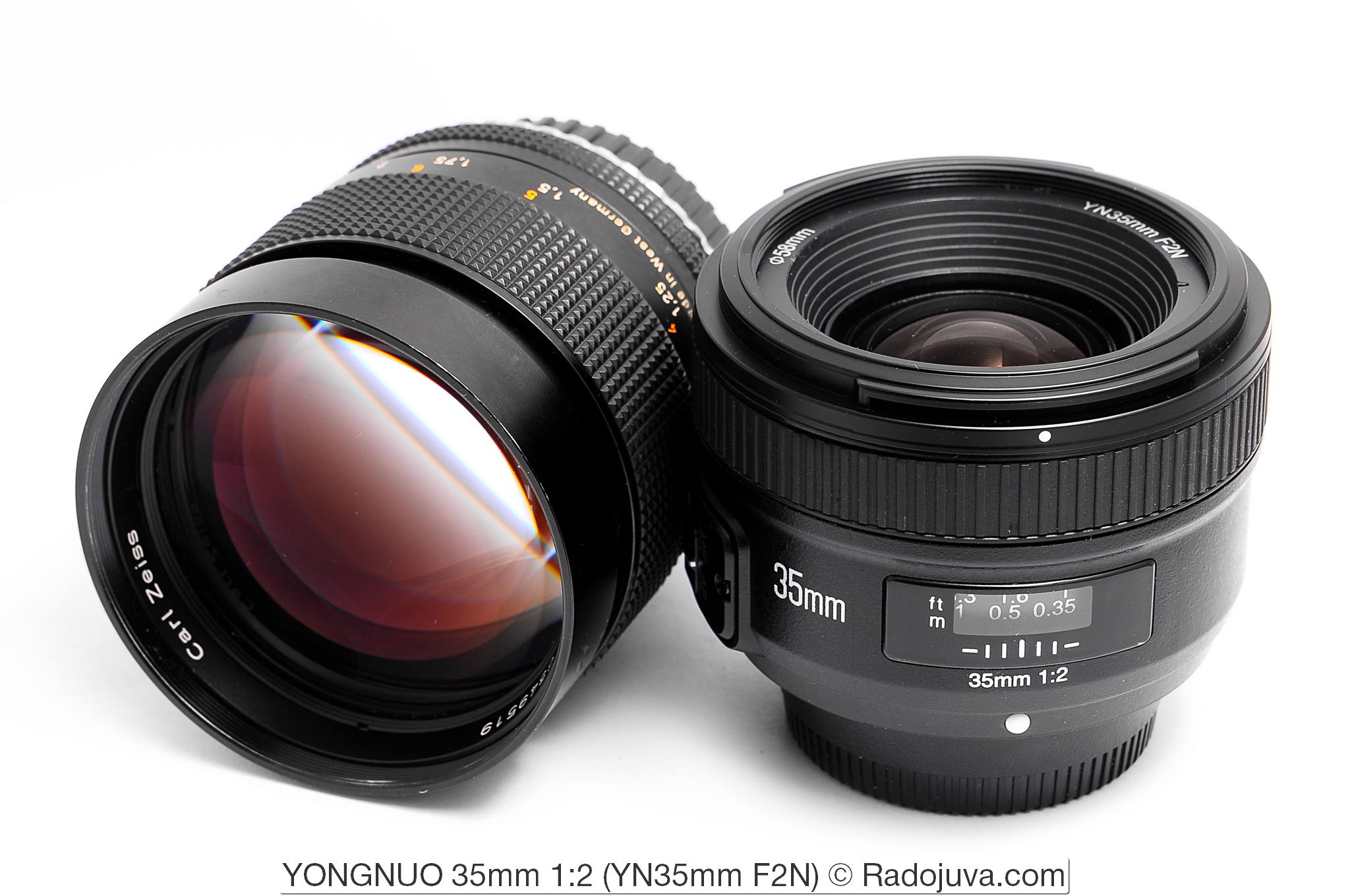
Noble Carl Zeiss Planar 1,4 / 85 T * (Lens made in West Germany, C / Y) and unpretentious YONGNUO 35mm f / 2 (YN35mm F2N)
Image quality
Image quality is at a decent level. Not to paint for a long time: YONGNUO 35mm f / 2 is optically no worse than the original Nikon AF Nikkor 35mm 1: 2D.
YONGNUO 35mm f / 2 inferior Nikon DX AF-S Nikkor 35mm 1: 1.8G by resolution, but wins by chromatic aberration.
Optical advantages and disadvantages are described in the results.
Below is a GIF animation of optical circuits Canon lens EF 35mm 1: 2 и Yongnuo Lens EF 35mm 1: 2 Yongnuo Lens Made In China. The same optical scheme is used for the lens from this review.

GIF animation demonstrating optical schemes of lenses Canon lens EF 35mm 1: 2 и Yongnuo Lens EF 35mm 1: 2 Yongnuo Lens Made In China (the same scheme is used for the lens from this review)
Sample photos on Nikon D90
Photos in the gallery below are shown. without treatment... Some of the photos are converted from the original RAW files using the original Nikon ViewNX-i utility without additional adjustments, the other part is the original on-camera JPEG.
Download source files in format JPEG can at this link (114 files in the '.JPG' format, 735 MB). Small photo report on Nikon D90 and Yongnuo 35mm f / 2 (YN35mm F2N) can be seen here.
Sample Photos on the D700
Photos in the gallery below are shown. without treatment Conversion of source RAW files with the original Nikon ViewNX-i utility without additional adjustments.
You can download source files in RAW format (14-bit, lossless compression) at this link (48 files in the '.NEF' format, 681 MB).
Sample photos on Fujifilm FinePix S5 Pro
Photos in the gallery below are shown. without treatment, source on-camera JPEG. Part of the photo was obtained using a polarizing filter Hoya 58mm PL-CIR.
Download source files in format JPEG can at this link (114 files in the '.JPG' format, 611 MB).
Sample photos from a small processing can look in my gallery at 500px.
The main differencesI'm between Nikon DX 35 / 1.8G and Yongnuo 35mm 1: 2
- Nikon DX 35 / 1.8G is a class lens Nikon DX (for cropped cameras), Yongnuo 35/2 is a class lens FX (for full-format cameras).
- Nikon DX 35 / 1.8G 1/4 foot lighter than Yongnuo 35/2. During real photography, the difference in aperture is not felt.
- Yongnuo 35/2 is a newer lens introduced 7 years after the release Nikon DX 35 / 1.8G.
- Nikon DX 35 / 1.8G 20 grams heavier than Yongnuo 35/2. Yongnuo 35/2 does not always come with an integrated hood.
- У Nikon DX 35 / 1.8G Yes rubber lens mount sealwhich makes the mount mounts dustproof and waterproof.
- Lenses use different focus motors. Yongnuo 35/2 uses a conventional micro motor, Nikon DX 35 / 1.8G uses a Nikon SWM ultrasonic motor.
- Nikon DX 35 / 1.8G has the ability to constantly manually control the focusM / A'. For manual focus, the Yongnuo 35/2 must be set to 'MF'.
- Different optical schemes. Nikon DX 35 / 1.8G uses a modern optical scheme, including one aspherical element, which allows to achieve better image, especially on open diaphragms.
- Nikon DX 35 / 1.8G worse for macro photography due to a more meager maximum magnification factor (1: 6.3 vs 1: 4.3).
- Yongnuo 35/2 has a window with a focus distance scale in meters and feet.
- Yongnuo 35/2 uses 58 mm diameter filters, Nikon DX 35 / 1.8G - 52 mm in diameter.
- Modern Nikon cameras can automatically correct some distortion of the Nikon 35 / 1.8G lens. With Yongnuo 35/2, some image enhancement functions will not be available, since this lens is not in the memory of modern cameras.
- New Nikon DX 35 / 1.8G It costs significantly more than the new Yongnuo 35/2.
The main differences between Nikon 35 / 2D and Yongnuo 35mm 1: 2
- Yongnuo 35/2 is a newer lens introduced 21 years after the release Nikon 35 / 2D.
- Nikon 35 / 2D about 20 grams heavier than Yongnuo 35/2.
- Lenses use different optical systems.
- For focusing, the Yongnuo 35/2 uses a built-in micro focus motor. Nikon 35 / 2D has inboard motor focusing and focusing due to the focusing motor built into the camera. This is one of the main functional differences between the lenses.
- Unlike Nikon 35 / 2D, during focusing, the Yongnuo 35/2 does not have an extension of the body rim (the trunk does not move out).
- Nikon 35 / 2D It has an aperture control ring, which Yongnuo 35/2 does not have.
- Yongnuo 35/2 does not have the depth of field scale and the infrared shift marks that the Nikon 35 / 2D.
- Yongnuo 35/2 uses 58 mm diameter filters, Nikon 35 / 2D - 52 mm in diameter.
- Optically, the lenses are close to each other.
- Modern Nikon cameras can automatically correct some lens distortion Nikon 35 / 2D. With Yongnuo 35/2, some image enhancement functions will not be available, since this lens is not in the memory of modern cameras.
- New Nikon 35 / 2D It costs a lot more than the new Yongnuo 35/2.
My experience
Many users asked me to prepare a Yongnuo 35mm 1: 2 review, so I bought a lens specifically for this purpose.
I think Yongnuo 35mm 1: 2 is an adequate alternative to the popular Nikon DX 35 / 1.8G and for old Nikon 35 / 2D... The only thing that confuses me about Yongnuo 35mm 1: 2 is the unknown about the quality spread between the models, as evidenced by completely different information on the network. If all the models sold are optically and mechanically close to the version from my review, then the Yongnuo 35mm 1: 2 should soon become a legendary / folk lens.
I liked Yongnuo 35mm 1: 2 so much that I I recommend it for purchase and use. Yongnuo 35mm 1: 2 has an excellent price / quality ratio.
I used this lens very actively for a month with different cameras, shot about 5.000 frames on it, while it withstood all the loads.
If there is a choice between Yongnuo 50mm 1: 1.8 and Yongnuo 35mm 1: 2, then I recommend the latter. The reasons for this recommendation: 35 mm on the crop can serve as a good staffer, with it it is much more convenient to carry out a diverse survey, it is devoid of some mechanical flaws that I met with the model Yongnuo 50mm 1: 1.8.
I am often asked about cheap wide-angle or standard / universal fix for crop, often the question concerns Soviet lenses of the brand WORLD. Now I will recommend saving up some money and decide on China-plastic-fiction.
For some users, I would even recommend replacing any standard whale lens class 18-55/3.5-5.6 to Yongnuo 35/2. The 35mm focal length is in the middle of the 18-55mm range, (18+55)/2=36.5. EGF The lens on Nikon DX cameras is 52.5 mm (fifty dollars), which is the classic standard focal length. Thus, Yongnuo 35mm 1: 2 can be an everyday prime lens for Nikon DX cameras (i.e. for crop).
Video review
A short video review is possible watch on my Youtube channeleither here:
Prices
Prices for the YONGNUO 35mm f / 2 (YN35mm F2N) lens at aliexpress.com can see and buy at this link.
On the aliexpress.com This lens is sold at the cheapest prices. In all other places, for example, in local stores of the countries of the former CIS, Yongnuo 35mm 1: 2 costs a little more.
Results
Yongnuo 35mm 1: 2 turned worthy copy... The price / quality ratio is high (this link is only $ 100). Of course, there are small flaws, but in general it is very attractive lens for amateur and novice enthusiasts.
Advantages
- very low cost (about 100 dollars)
- built-in focus motor, compatible with the younger line of Nikon DX cameras
- virtually internal focusing, no rotation of the focus ring during auto focus
- smooth rotation of the focus ring, convenient enough manual focus
- presence of a window with a focus distance scale
- good build quality: metal bayonet mount, rubberized focus ring, light weight, bayonet hood
- small MDF, good magnification factor for macro photography
- rounded seven-blade diaphragm
- no focus shift
- confident sharpness at F / 2.0 in the center of the frame
- good contrast, neutral color reproduction
- fairly round blur discs on F / 2-F / 2.8 apertures
- moderate distortion
- moderate chromatic aberration in the center of the frame
- low vignetting on Nikon DX cameras (crop)
- good lateral light resistance
Disadvantages
- low focus speed
- not always sure focus
- slight noise from the focus motor
- incorrect indication of the focusing distance (the lens always reports to the camera only one of the two 'hardcoded' values about the distance to the subject)
- the survivability of this lens and the spread in quality are unknown
- lack of a hood in the delivery set (maybe not all sets are delivered without a hood)
- lack of constant manual focus control
- focus ring and distance scale have different directions of rotation (psychological discomfort)
- the direction of rotation of the focus ring is opposite to the original Nikon Nikkor lenses
- direction of 'AF / MF' switch opposite to original Nikon Nikkor lenses
- small effect of 'Focus Breathing' (changes in viewing angle during focusing)
- the lack of the depth of field and strange strips-trompe l'oeil that imitate it
- there may be incompatibility with some cameras and / or teleconverters (no exact data)
- low battery with some cameras turned off (e.g. D3000)
- blinking of the memory card access lamp with some cameras in the off state
- lack of data about the lens in modern cameras, which makes it difficult to automatically correct some types of distortion (distortionvignetting etc.)
- not enough round blur discs on F / 3.5-F / 19 apertures
- tangible vignetting on full-frame cameras and open apertures
- drop in sharpness at the edges and corners of the frame on full-frame cameras
- Poor backlighting due to specific glare (see examples)
Please ask all questions regarding the lens in the comments, I will definitely try to answer. Comments do not require any registration or any personal data.
UPDATED: review appeared Yongnuo 40mm 1: 2.8 (model YN40mm F2.8N).
Comments on this post do not require registration. Anyone can leave a comment. Many different photographic equipment can be found on AliExpress.
Material prepared Arkady Shapoval. Training/Consultations | Youtube | Facebook | Instagram | Twitter | Telegram

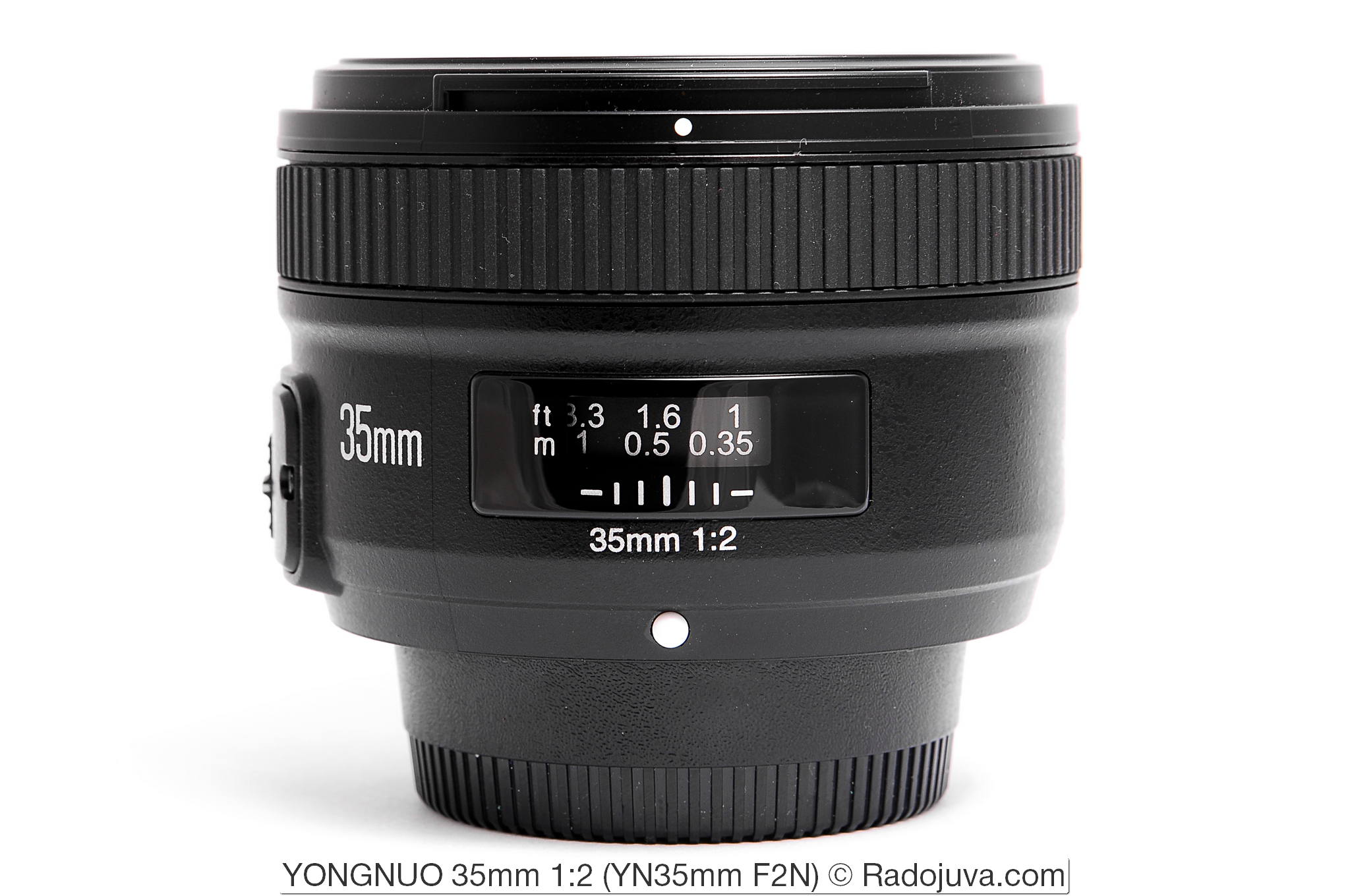

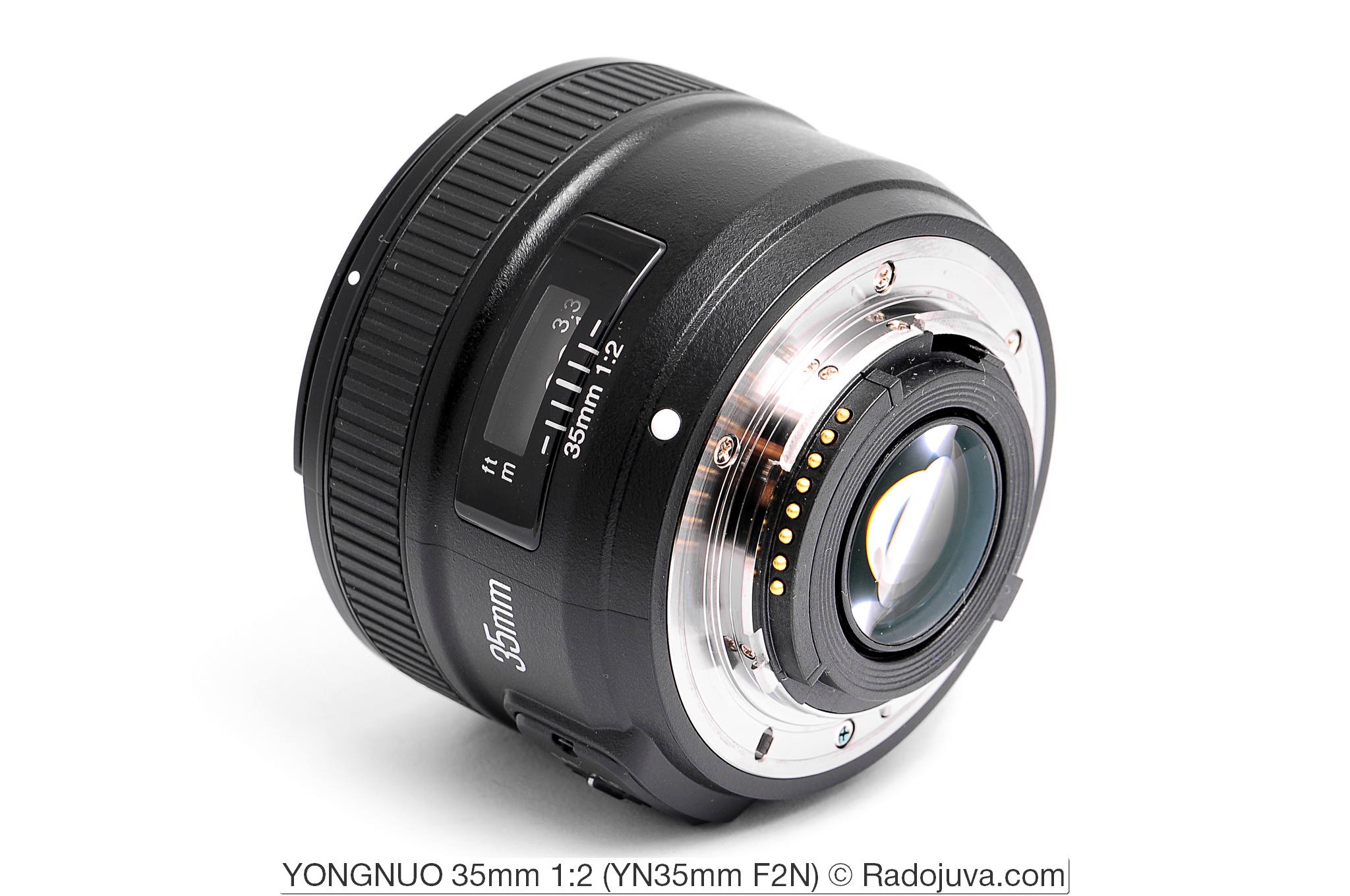
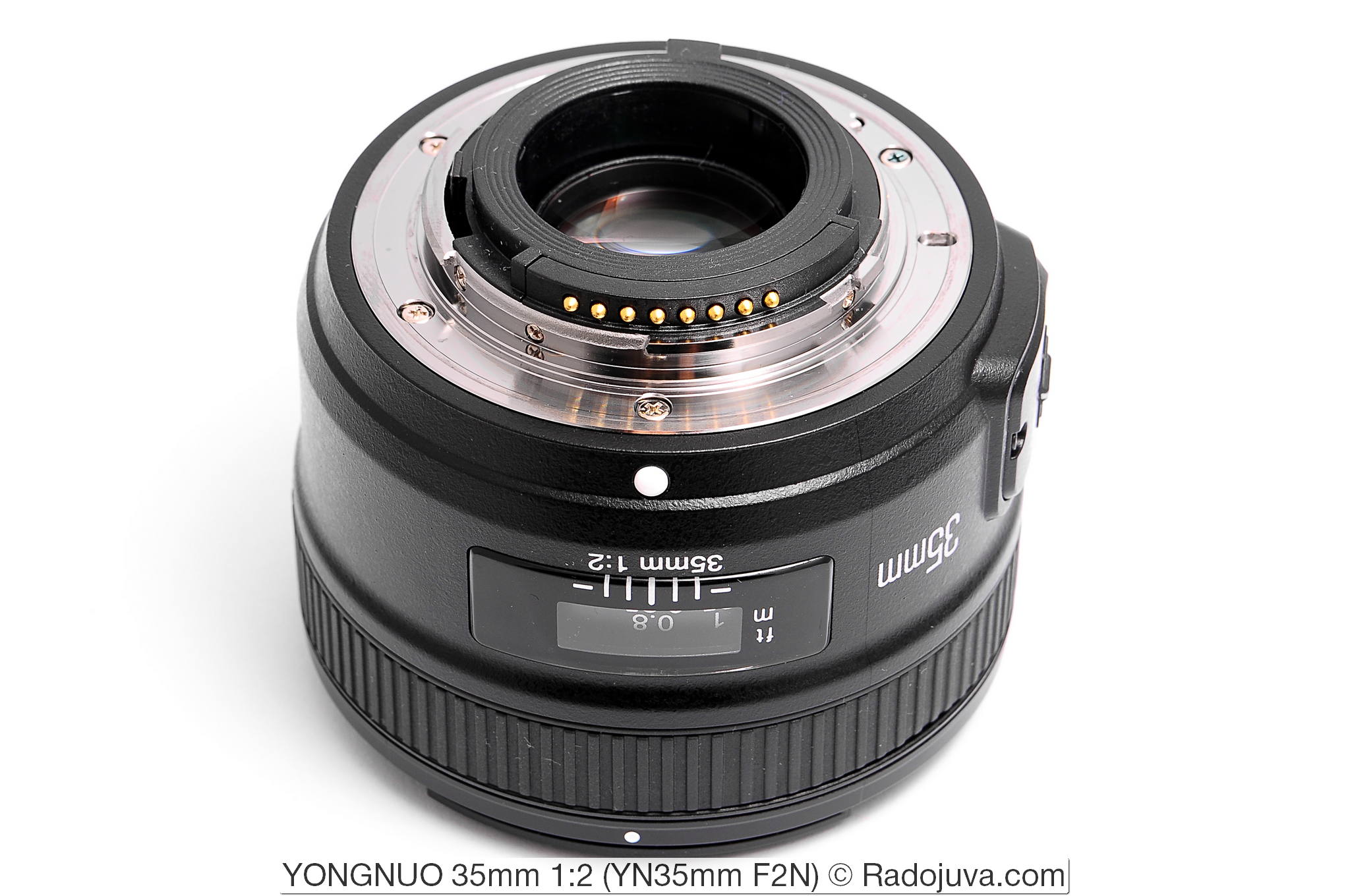
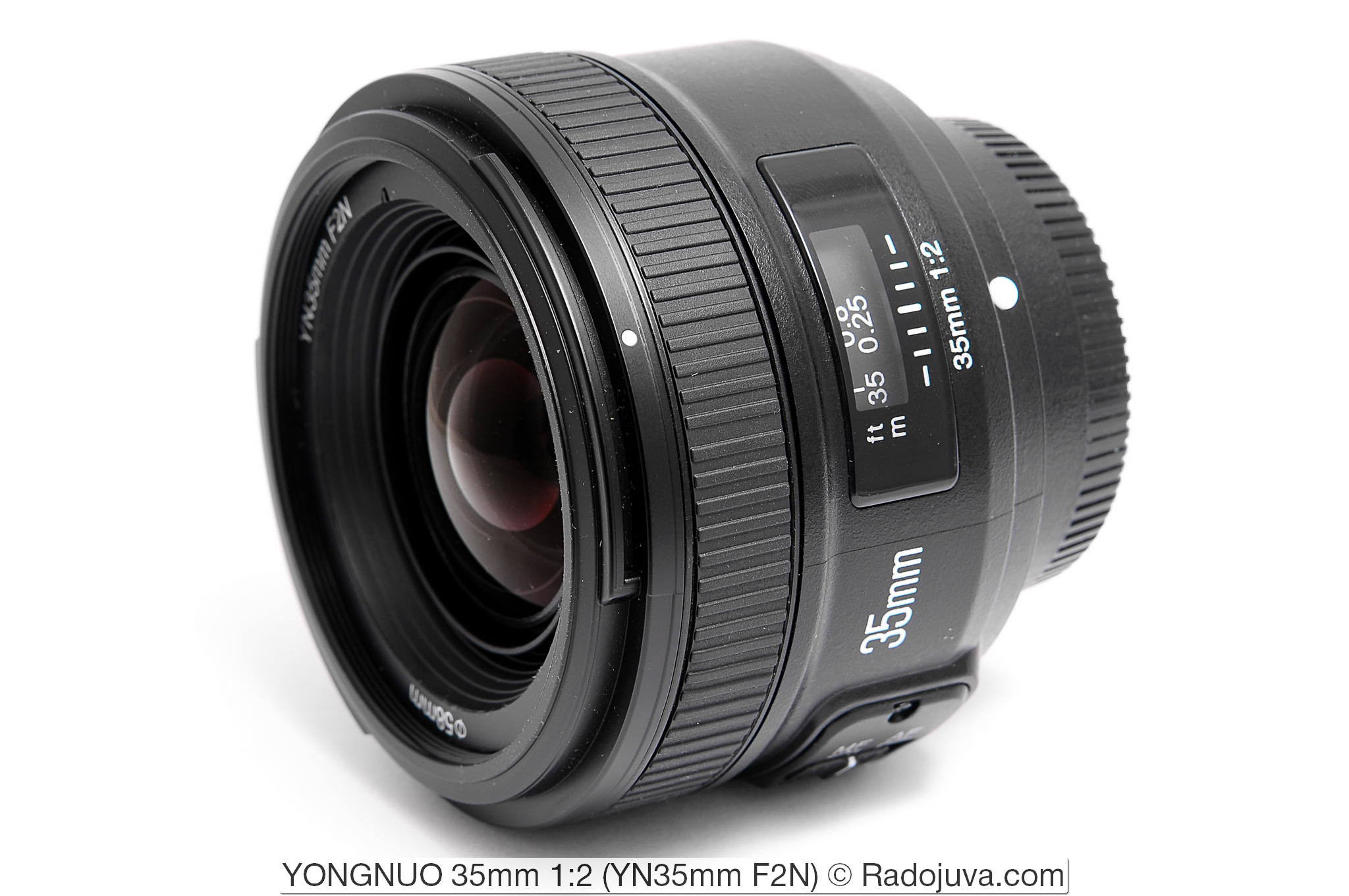
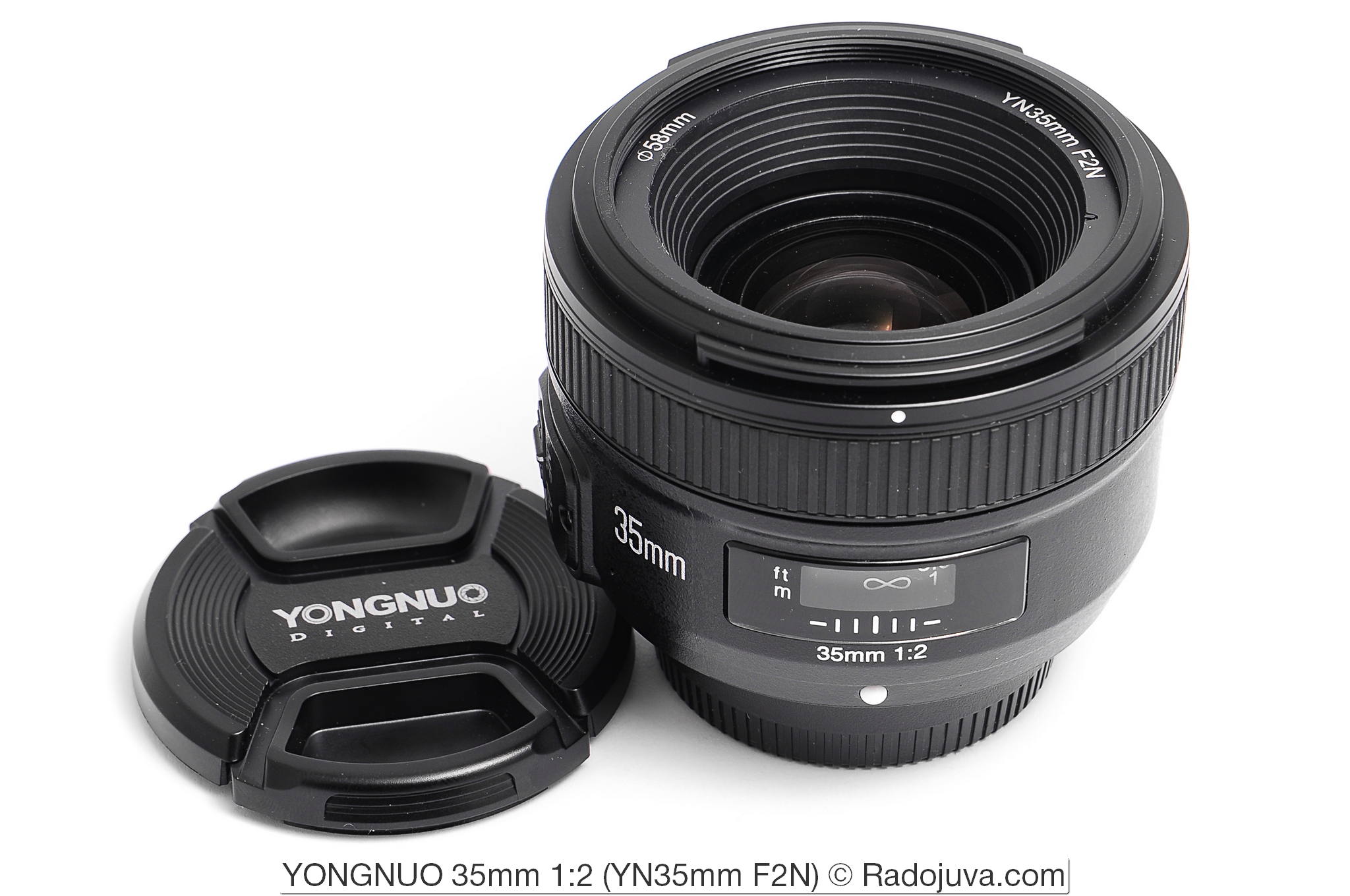
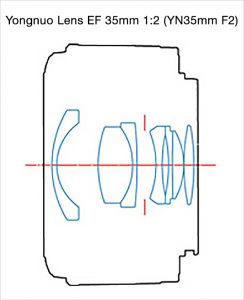
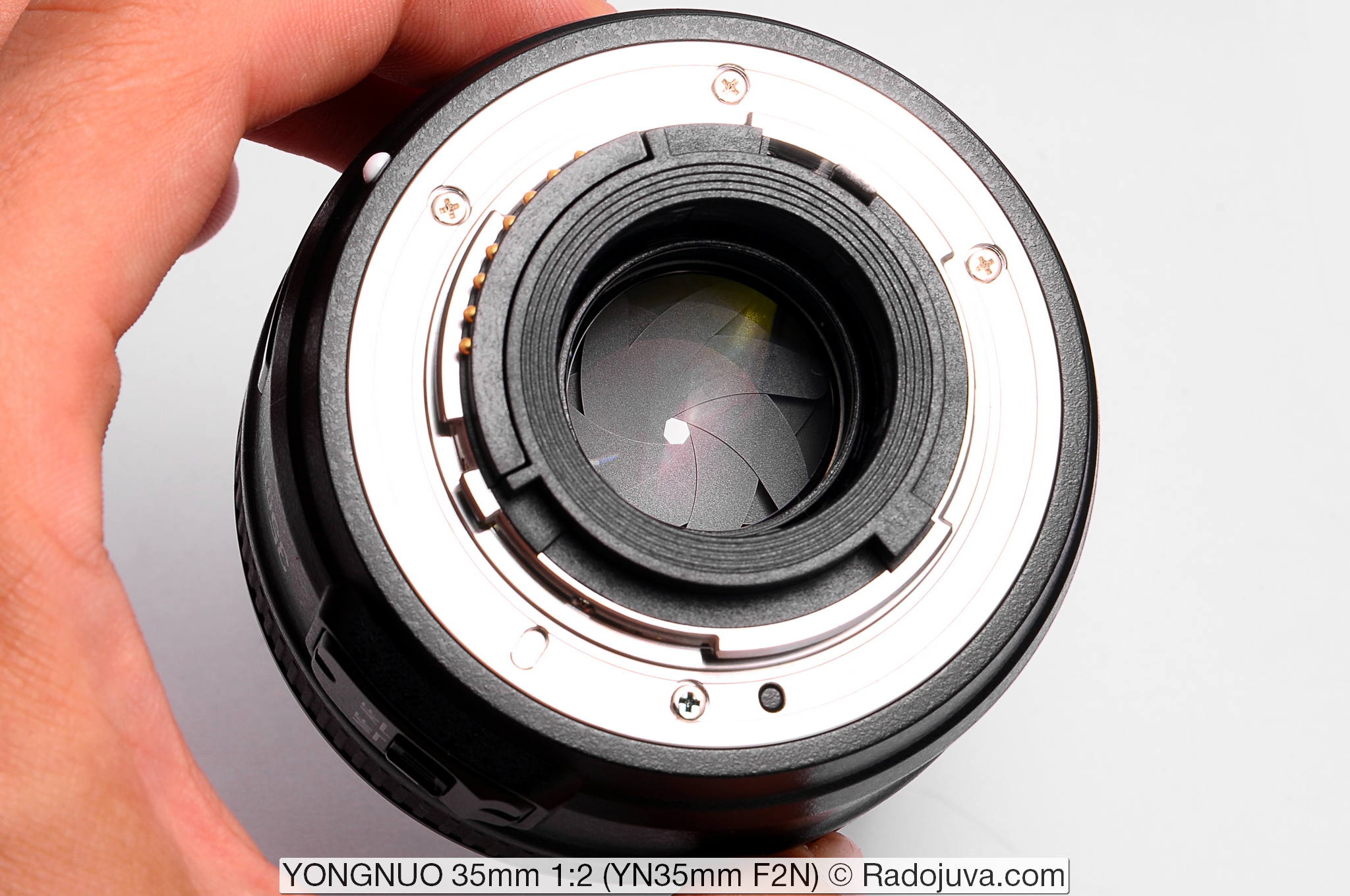
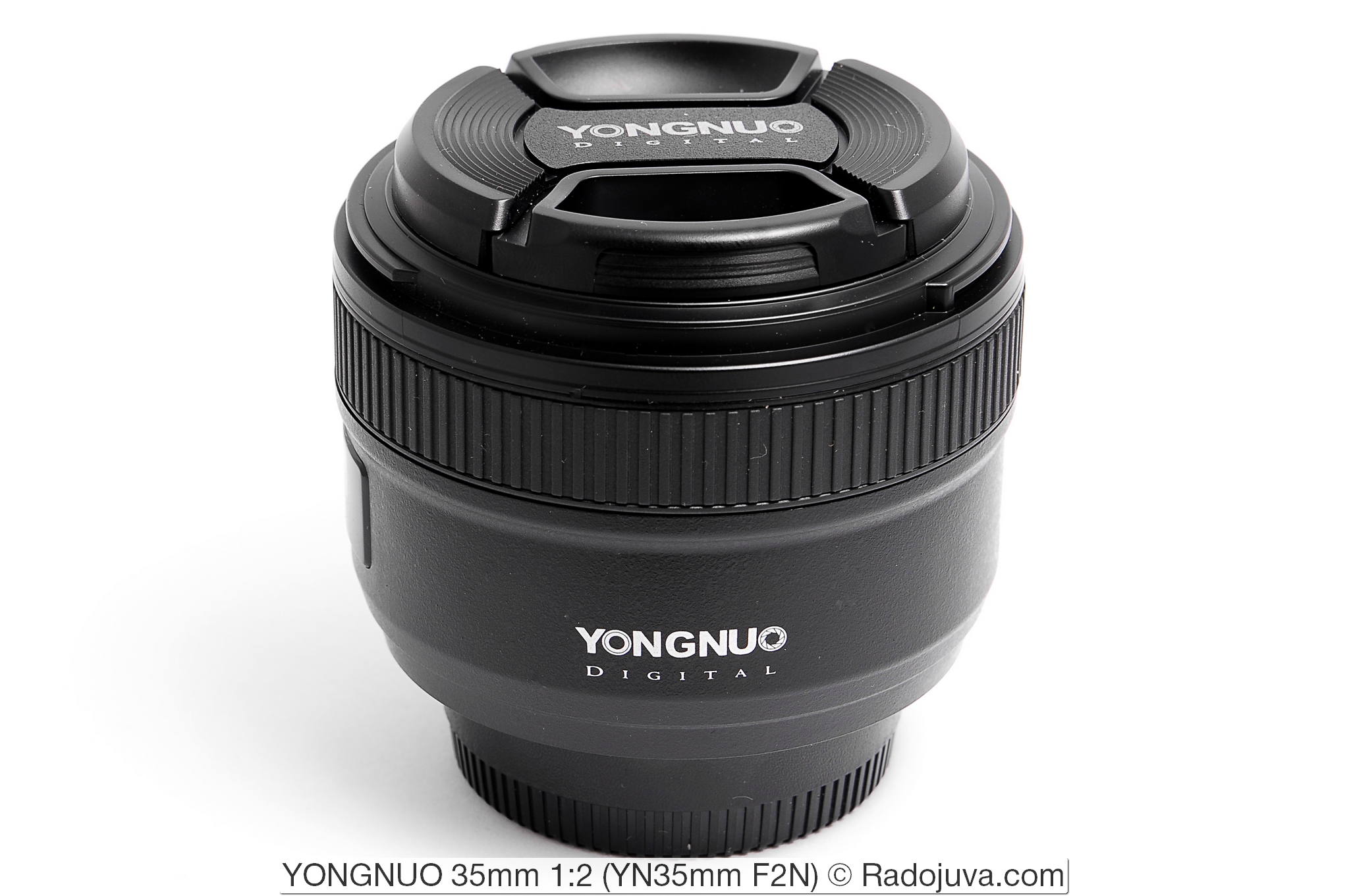




































































































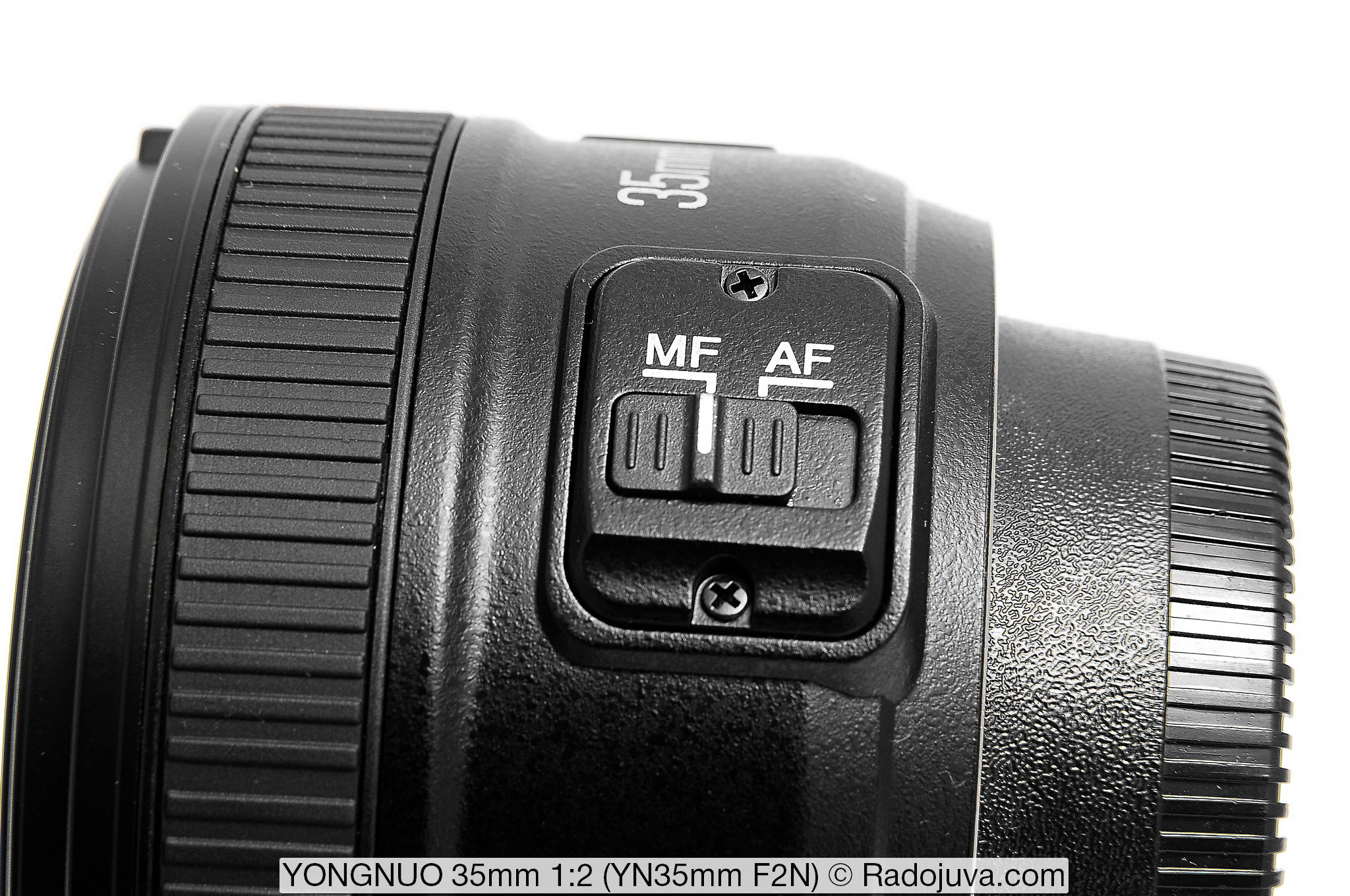
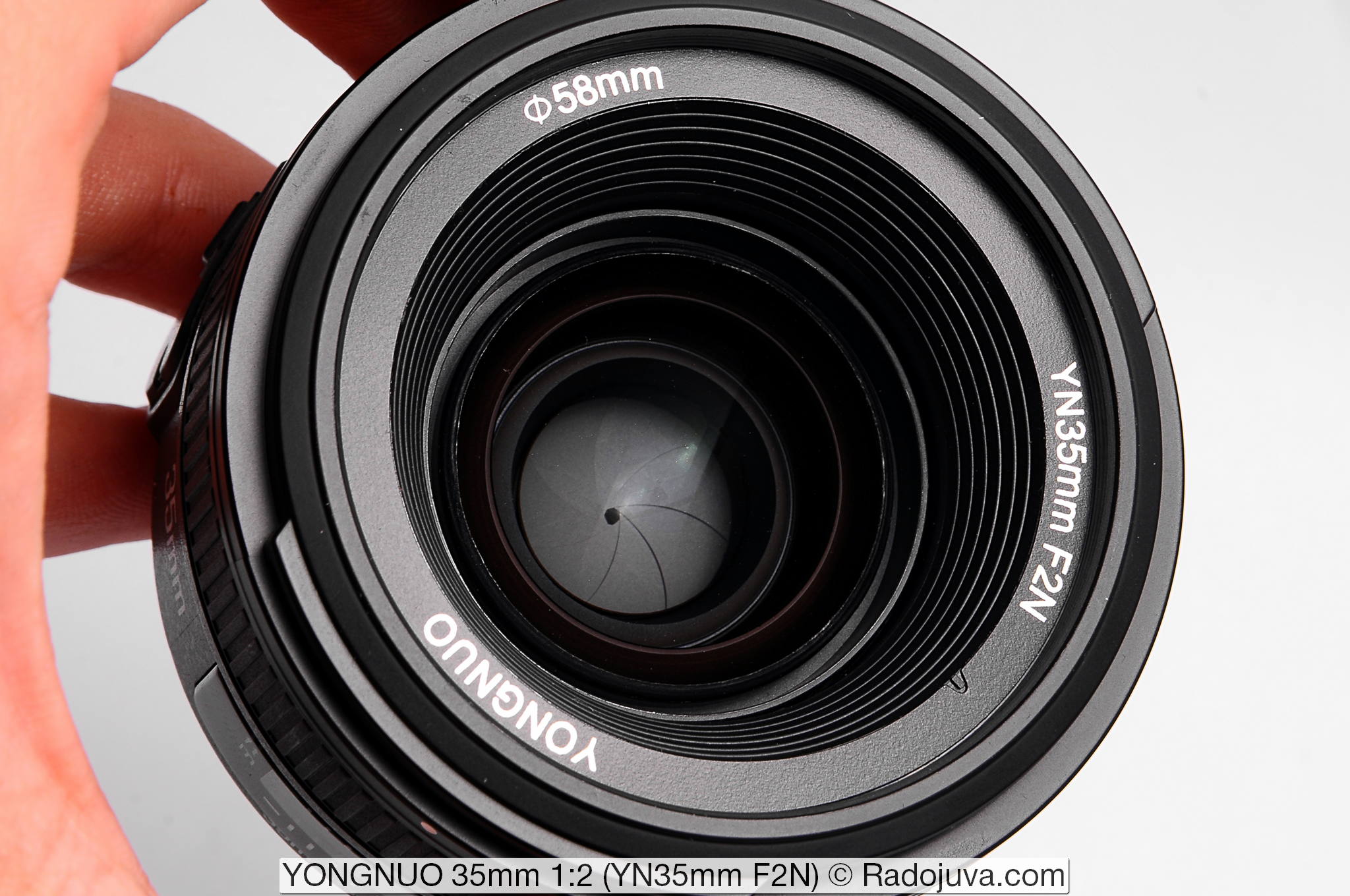
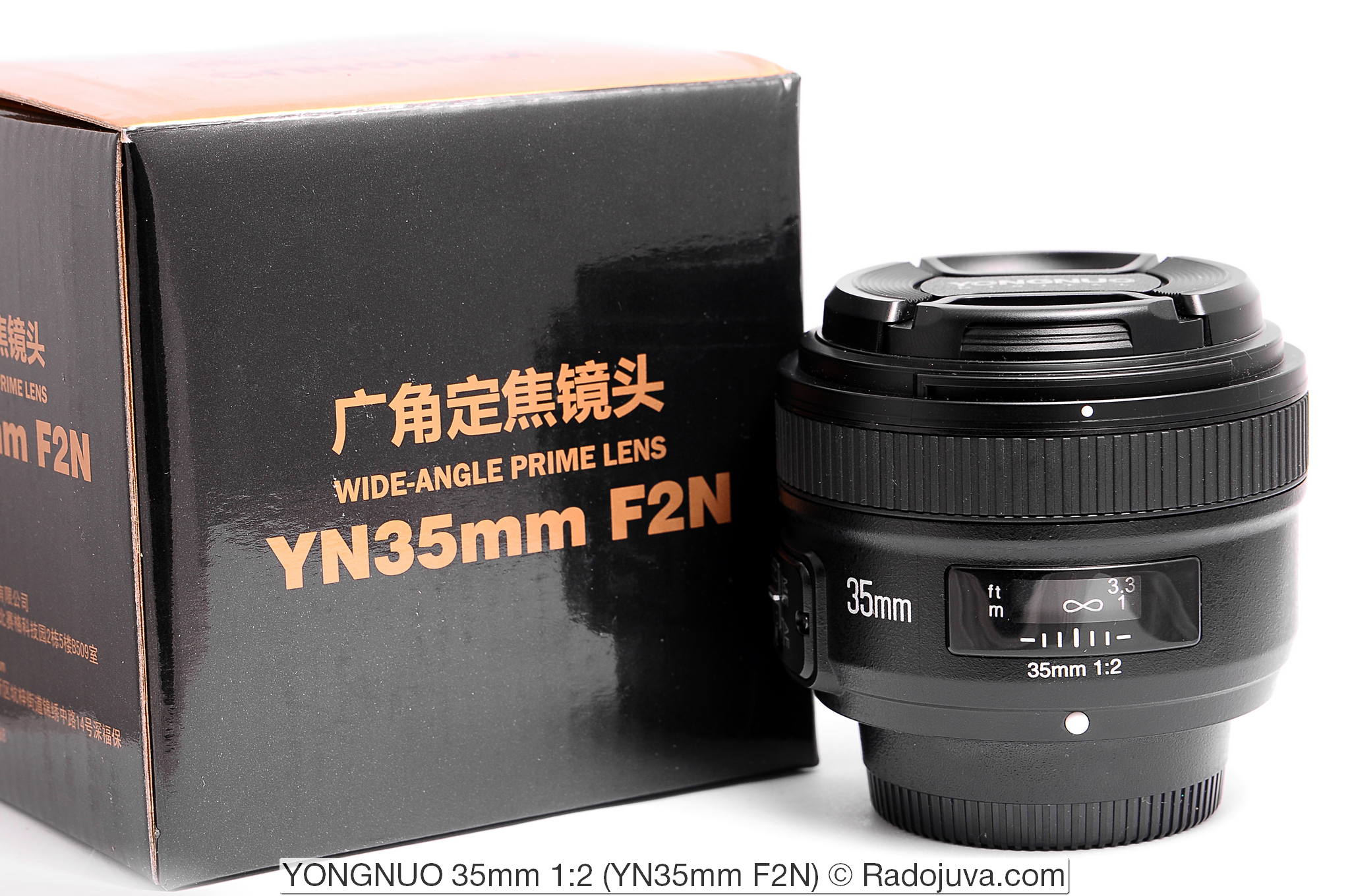
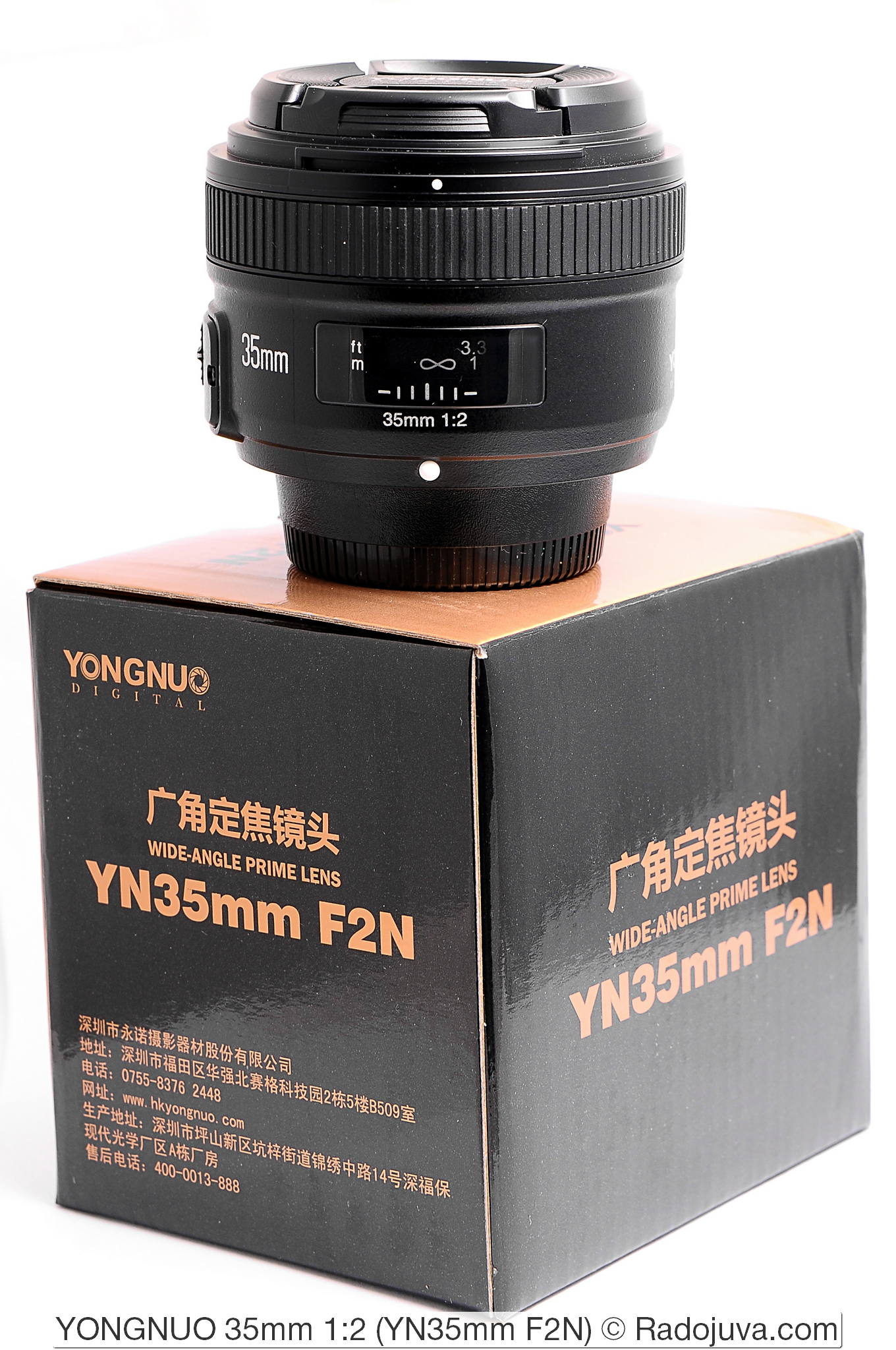
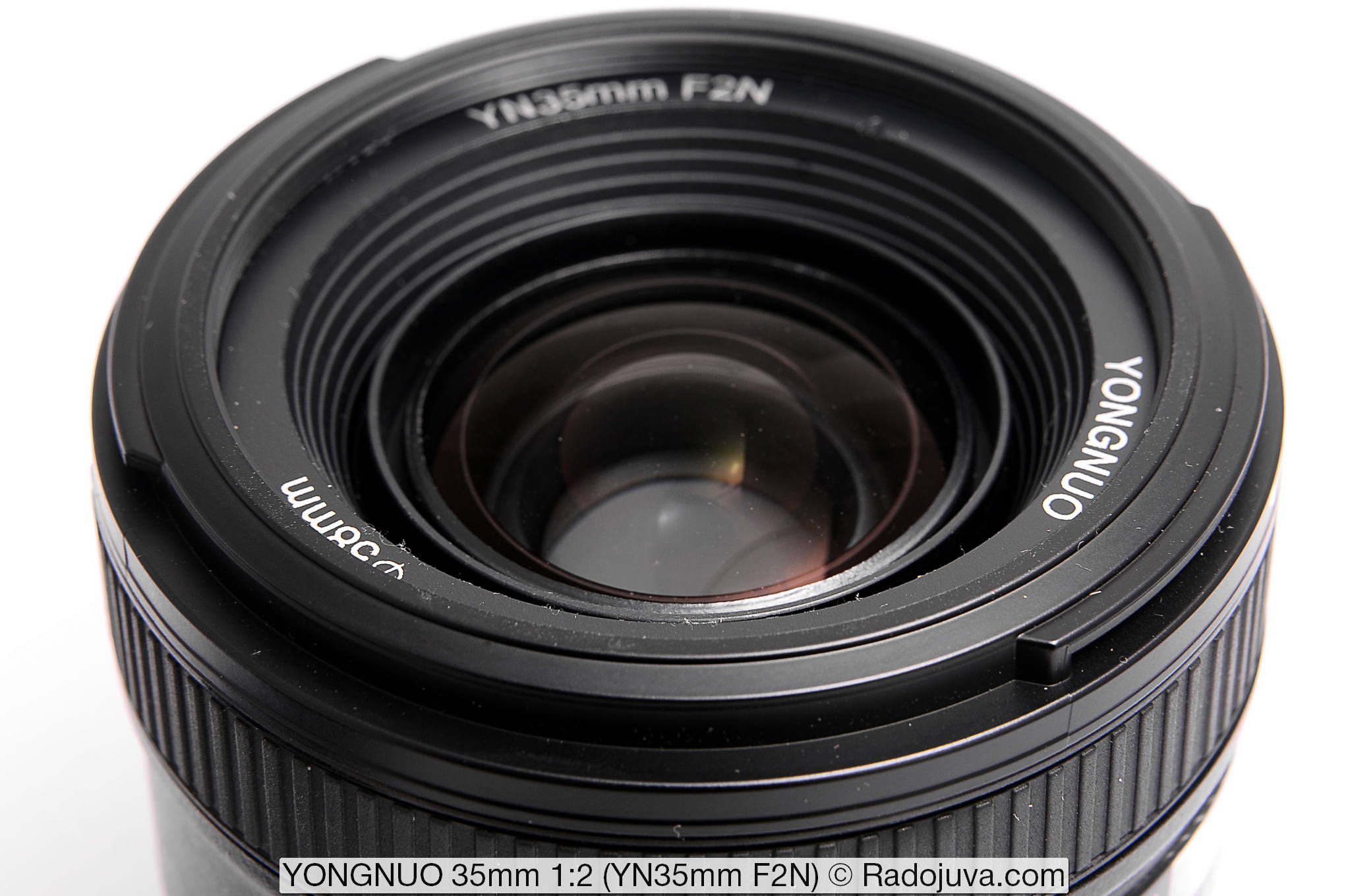

Here I found instructions for YongNuo products (including the YN 35mm F / 2 lens) in Russian: http://www.yongnuorussia.com/support/
Maybe someone needs ...
There is only for the version for Canon for 35/2
In China you can get it (if you have friends and someone will bring it to you!) For 400 yuan, then about 58 dollars! Personally, I specially despised shots from 12 copies taken at random in the store and when checking on a computer I did not notice any difference between the files, it is understandable. It is easier to make fixes, besides, good engineers for the production of lenses have long appeared in China, most of them previously worked in factories of brands that are located in China itself, adopted experience and are now applying in other factories. Take the Chinese brand Laowa - they make great lenses. So far, the Chinese lack autofoculars, or simple electronic contacts on manuals. I think they will appear. By the way, as far as I'm concerned, the Chinese have long been producing high-quality optical glass for half the price of foreign ones, and then it remains to polish and clarify the lenses ...
Yes, the same Korean Samyang began to produce autofocus lenses.
Arkady, typos:
"I indicated the prices I am guided by the average current value"
"The lens behaves well, rarely fails in focusing"
“Nikon DX 35 / 1.8G is 1/4 stop lighter than Yongnuo 35/2” - like a third of a stop here?
1,234567890 times lighter - less than a third, although more than a quarter.
Fixed
closer to 1/4 stop. Exact value in numbers (2 * 2) / (1.8 * 1.8) = 1,2345
Well, yes, I simply relied on the standard series. Rounding played a role)
I ordered the same today at your link. Let's see how good he is.
Arkady, in the review you say that for portrait shooting you will have to retouch the model, because the excessive sharpness for such photos is on f2.0. On cropped cameras, the same result will be (D3300)? Compared to YONGNUO 50mm, which one will not be so sharp at f2.0
It was about specific shots in specific conditions and a specific model. You don’t have to worry about it.
Thank you.
I was able to shoot both Yongnuo - 35mm and 50mm on crop. The lenses are sharp enough, very good for their price. But, of course, they are somewhat inferior to similar Nikkors, perhaps this is even connected not so much with the optics itself, as with the best interaction of the Nikkor family with Nikon cameras.
For a portrait, I liked 50mm more - separation from the background, blurring the background. At 35mm, shooting a large portrait is accompanied by restrictions: first, it is easy to go beyond the MDF, which is unacceptable; secondly, due to the close distance, distortions of the proportions of the face are noticeable.
Otherwise, the lenses are very similar, so pick one - either 50mm or 35mm, whichever you use more often.
Thanks for the noted nuances. Of course, I'd rather choose Nicorr) Because I read reviews for the YN50 and decided for myself that I would not buy it. In this review, the YN35 looks decent. But he did not come to a final decision on the purchase.
Helios got 81-n, while I’m taking off with him.
Frankly, Helios 81-n is one of the best Soviet lenses, but not the best among the available modern optics. His fame is true for the Soviet era, but, to put it mildly, overestimated today. Alas, the Geliso 81-n is no better in quality than the Yongnuo 50mm. The arguments are: YN50 has a built-in focus motor and allows you to shoot accurately and quickly; it is equipped with electronics responsible for metering, so it works correctly with any Nikon device; in my opinion it is equipped with the best glasses and definitely better multi-enlightenment than Helios 81-n; finally, he is a third foot lighter than him. I do not know how much you took Helios 81-n, but the YN50 for its price, in my opinion, will definitely be better.
Not a third, but 1/4 stop. + Remember the aperture blades of the G81N and Yagi.
Sorry, of course, 1/4 stop.
I must also say that in general Yaga 50 / 1,8, especially the version for Nikon, is better than the G-81N.
Yes, for sure, the Nikon version was more interesting than the Canon version. YN engineers copied the case from Nikkor's lenses, and even took into account their past mistakes. As a result, holding the YN50 in hands is much nicer for Nikon than for Canon. For a long time there were not enough budget autofocus glasses, so the guys took the right market niche. I believe that after some time we will see the expansion of the line for Nikon.
I wonder what will happen with 85 / 1.8 and 100/2 for Nikon :)
The advantage of Helios in price) it is twice cheaper. And of course, autofocus is much easier and most importantly faster!
Industar 50-2 can be for 300-500 rubles. take + adapter for 50 rubles. to purchase. Those. it will be cheaper every 10 times than YN. But, understand, these are not comparable lenses in terms of functionality and performance. Here we are talking about the fact that the YN35 and YN50 actually became very close analogues of the Nikkor 50mm 1.8G and 35mm 1.8G (and the Nikkor 35mm is only DX, but F1.8, and the YN35 is suitable for FX, but F2.0). These are not Nikkor clones, since they are Canon clones in the case taken from Nikkor, but these are close analogues in terms of functionality and the result of work. Yes, they are slightly weaker than the originals, but they are also 3 times cheaper than new originals, used 1,5-2 times.
They are optically closer to 50 / 1.8D, 35 / 2.0D, i.e. to the lenses of the past generation.
Optically, of course, yes. They were cloned from Canon lenses of the previous generation, discontinued in that form and replaced with newer versions. But functionally, due to the focus motor, YN lenses, of course, hit the Nikkor 1.8G niche.
He has no virtues except that he will survive all on the shelf but will remain a dull shit from birth. Unfortunately.
Valentine, the 35th on the crop is ideal for shooting full-length portraits and not bad 3/4. Why use 52 mm EFR where it does not seem to be the best?
Alexey, this is how I write that if it is important to shoot large portraits, then 35mm will not work, it is better to take 50mm. And if such a task is not frequent, but on the contrary, waist and smaller sizes are often removed, then 35mm will be in the subject. Therefore, I answer your question - there is no need.
It is bad to shoot large portraits of fifty dollars - preferably 70mm or longer. At half a line, quite noticeable geometric distortions are obtained.
I would use the maximum for a half-length portrait (on the crop). On the other hand, the waistband can be removed and the 35th. It turns out that fifty dollars on the crop does not belong at all ...
Worked with YN50, and YN35. I will say the following:
1. Both are technically not bad, the picture is very similar. Difference in max. the aperture (YN50 - 1.8, and YN35 - 2.0) does not matter, because to eliminate wiggle, the YN50 requires a shorter shutter speed than the YN35.
2. Unlike the whale, YN does not have a stabilizer. The 50mm whale has F5.6 and the YN50 has 1.8. The difference in luminosity is 10 times. But the whale's stabilizer allows you to make the shutter speed longer, without allowing for blur, i.e. in practice, the gain in aperture ratio will be less. At 35mm this difference will be even smaller. Kit 15-55 VR GII at 35mm gives F4, and YN35 F2 - the calculated difference in aperture by 5 times. But due to stabilization, it will be less.
Please note that in automatic mode the camera often covers the aperture up to F4 and higher, therefore, when shooting with the automatic device, you may not feel any gain in aperture ratio at all. If you do not know how to work in M mode, do not know modes A, S, P, then at least choose the correct amateur modes, like “portrait”, etc. In this case, the device will more accurately work out your task.
In addition, if a not very successful specimen comes across (rather weak on an open one or having slight inaccuracies in focus), then the diaphragm will also have to be covered more often (on a covered one, contrast characteristics are better and more DOF). And then again, the gain in aperture ratio will be less.
3. The difference in focal length: the large-face portrait on the YN35 is limited by the minimum focusing distance and the resulting distortion of facial features when approaching the subject; in a confined space, the YN50 is more difficult to remove due to the small viewing angle (further away from the object). The difference in the depth of field for different cases can be calculated on calculators.
4. Disadvantages: YN50 sometimes lost touch with the camera. The YN35 did not always focus accurately. A variation in quality among different instances is possible.
5. Lenses are quite suitable for inexpensive cameras. When buying, decide what you will do with the whale lens:
a. If you leave the whale and are ready to take it as a second lens, then it is better to have a YN50. It will allow you to shoot a lot, including portraits in the open and in dark places, and in the street in sufficient light, where other focal lengths are required, you can use the whale, covering the diaphragms. It is important to remember that the whale is 50 mm darker 1,5 times than 35 mm (F5.6 versus F4.5). The gain in aperture from YN50 will be greater than from YN35 compared to a whale.
b. If you will not use the kit (if you don’t, sell it, you won’t carry it with you), but want one lens, then it’s logical to take YN35. A focal length of 35 mm is almost in the middle between the cetaceans of 18 and 55 mm. The YN35 can indeed be considered a universal crop lens.
6. For expensive cameras, buying YN does not make much sense, you get big investments in the camera and saving on lenses. Expensive cameras are often used in commercial activities. But for YN there is no service, there is no long operating time (it can unexpectedly fail), components of a budget level are used. YNs are pretty decent lenses, but the Nikon 50 1.8G and Nikon 35 1.8G are better with the camera. This affects compatibility (freezing, determining the distance, exposure accuracy, distortion correction, etc.), it is also determined as a picture (Nikon has more accurate color reproduction, better contrast). Think, if this is important for you, it might be worth taking your own Nikon.
Thanks for the detailed comment.
I would probably add my subjective opinion regarding comparison with whale lenses. Optics YN50 and YN35 are higher than whale in quality. Whale produces something worthy on the F8-16 (in bright daylight or when shooting with flashes). These glasses give a good picture, starting with open, and just good, starting with F2.8-3.5. I don’t know how YN managed to make autofocus lenses so cheap, with a good body, metal mounts, decent glass and multi-illumination. It’s like they weren’t seriously engaged in optics before, and it’s just not clear where the not so simple technologies were deployed from so quickly. In general, just take off my hat.
Michael, for cameras with a built-in focus motor (including all the expensive models that you write about in paragraph 6) there are budget Nikkor 50mm F1.8D and Nikkor 35mm F2.0D, which in quality will probably be better than YN35 and YN50 , although they are also made in China. New ones will be slightly more expensive than YN, but in the secondary market there are a lot of good copies at the price of new YN or even a little cheaper. Nikon cameras always work better with native lenses. And Nikon, even in the most budgetary products, keeps a certain level in quality.
In this review, I have compared the prices of Yongnuo 35mm F / 2 with all autofocus 35s (30s and 40s) new or used. under Nikon. At the cost of the new (new) Yongnuo 35mm F / 2 there is not even a used 35/2 MKI used (costs 1.5-2.5 times more expensive).
> New ones will be slightly more expensive than YN, but in the secondary market there are a lot of good copies at the price of new YN or even slightly cheaper.
I have never seen an af 35-current under Nikon DSLRs cheaper than the new Yongnuo 35mm F / 2.
It is not worth comparing 35-weaving and 50-weaving, it is easier to make 50-weaving than 35-weaving, and there are simply different lenses.
It’s cheaper) I got my 35 / 1.8 for $ 65 in good condition. It’s a pity that after I acquired the yaga.
So lucky, in the public domain on the secondary, there are no such prices.
$ 65 worth FX or DX?
Of course DX. It can certainly be argued that the comparison is not correct and Yaga for full-frame cameras, but:
- I don’t think that owners of full-frame cameras will be buyers of this lens. It is mainly bought and used by crop owners who do not have money or even feel sorry for the 35 Nikon version of the crop (he himself is, but then realized that it is better to strangle the toad)
- Arkady just has pictures from the full-frame 700 - you can see what aperture they were taken with. I think the whale can do the same at 8-11. Sense then from aperture? Artistic ones with an open view, of course, look good on it when the subject is in the frame, and the edges are blurred - no matter whether it's bokeh or lens problems. Another disadvantage for full frame users. Have 2 widths for different things? If only as a spare for change.
There in the archive there is also architecture / landscape at F / 2.0 and the edges of the corner are certainly not the same as in the center, but you should not expect to see a "monocle" there. On the same D700, I managed to shoot a couple of shots, 50 percent on the open, everyone is happy, everyone is in openwork. I don't really defend the lens as I would prefer the native ones myself, but the Yongnuo 35/2 is really so good that it is sometimes good.
for Alfred:
Nikkor 35mm F2.0D is still in production in Japan.
If you do not believe me, I have a 35 / 2D purchased in 2013 in Japan, released for the Japanese market with the mark Made in Japan.
Nikon has all 35 Japanese Nikon 35 / 1.8G FX и Nikon 35 / 1.8G DXwhich are made in China.
Arkady, thanks for the review! If it does not, answer one question. I looked at your RAW files for the D700, and noticed that by default you shoot with a Neutral profile adjusted in sharpness to a maximum value of 9 and in saturation to a value of 2 from a maximum of 3. Does this over-focusing of the camera interfere when shooting portraits or Do you correct it later?
PS I don’t know what parameters were in the D90, but perhaps excessive sharpness on the model is also associated with an overestimated parameter of induced focus in the camera, which may give an incorrect idea about the properties of the lens itself. Sorry if I didn’t exactly formulate. And thanks again for your work.
Well, add koment.
The oversharp of photos in the reviews makes me a little jarring. IMHO, the pictures are unnatural, as if drawn with a pencil over a real drawing, especially if there is a small stir - it just starts to ripple. And, of course, oversharp artifacts are very striking, especially noticeable in contrasting transitions: there are, as it were, halos around the contrasting border.
This, of course, is tasteful: the author likes it, the public likes it, Vanya doesn’t like it = problems of an individual Vanya.
Accordingly, to your question “does it bother you?”: Does this sharpness bother you personally when viewing photos? The answer to this question will be the answer to yours.
I would like to hear the comment of Arkady himself. He writes “The photos in the gallery below are shown without processing. Some of the photos are converted from original RAW files using the original Nikon ViewNX-i utility without making additional adjustments, the other part is the original on-camera JPEG ”. If Arkady took and converted photos with standard profiles, this corresponds to what was said. But if he used a special profile (in the camera and converter), in which the sharpness was increased to the maximums and other characteristics were added, then, in my opinion, it is not entirely correct to say that there was no processing. In particular, sharping by means of a camera or a converter is a real element of post-processing. And this means that from the presented photographs you can make an erroneous conclusion about the presented lens or camera. Since only Arkady himself can reliably clarify and confirm / deny this, fortune-telling is useless here. We hope that Arkady will give clarifications on this issue. Thanks in advance!
In the review, the photographs are really shown without processing, while converting the source RAW files, I just turn on Nikon ViewNX-I, select all the necessary RAW files and press export (CTRL + E) without any other manipulations. In confirmation of the above, you can carry out the same manipulations with RAW files from Nikon D700, the link to which is indicated in the review and get the same result. For the gallery on the website, photos are compressed up to 2048 pixels on the long side with a quality of 70% + watermarks with EXIF data are added.
In profiles, I often have a sharpness of +9, and in general I am a very big fan of tweaking the shooting profiles in order to immediately get a good result, in my opinion. There are certain tricks.
A little lyrical digression about why I use these or other profile settings:
During a commercial shoot, I need to immediately show a beautiful result to the client. All the shootings that relate to work, I am doing with profiles that wind up sharpness and saturation. Shooting always takes place in RAW. This is done for the following reasons:
1. The client needs to show immediately a finished and beautiful picture. On a small camera display, it is not always clear what and where. And the better = the sharper / richer the picture, the more satisfied and calmer the client.
2. When developing RAW files using third-party converters, all these settings are reset, or rather, they are not perceived by non-native software. As a result, you can watch “naked” RAW and twist it to your liking - with smooth color, contrast and the desired sharpness.
3. Everything is removed with a clear understanding that everything will be wrong in the converter. Over the years, this approach has been developed.
4. It is very important to disable ADL, otherwise it becomes very difficult to display RAW with the same LIGHTROOM.
5. The camera initially sees neither color, nor light, nor sharpness - it sees only Bayer drawing and any (any!) Picture that the user looks at on the camera's display and / or converter is a mathematical restoration of the original real image projected by the lens. In fact, no one sees naked RAW files, because there is always debayering with a certain tweak. Which setting is correct and true - there is no answer. Why LR puts the base sharp at 25%, and not 30% or 0%, no one will say, it just happened historically and it is considered to be a "real raw file". Or why is the basic sharpness in the 'SD' profile equal to +3, and in 'NL' +2, and which is “more correct” - the standard profile or neutral?
6. The final picture is just a set of clever debayering algorithms with thousands of enhancements added. For example, LR uses lens profiles (compensates for distortion and vignetting), uses a camera profile (adjusts color for bayerization, color channels, and other subtleties such as HUE shift based on shadows / highlights). All this is a math game of beats.
7. Shooting with different techniques I had to teach myself to achieve or try to achieve a good result from any camera. By manipulating a huge toolbox of converters, I made sure that there are no cameras that are bad in color. All these “blue, green, warm” are just bits and bytes, sliders and converter percentages. I agree that in JPEG cameras give different results, but I have not yet seen a single camera, from which RAW file you cannot get a good / satisfactory result.
About the lens features:
Therefore, historically, for the review, I also use profiles to my liking in order to get a good result immediately. Unlike commercial shooting, for Nikon reviews I additionally include ADL, which visually expands DD (and some other enhancements). The original converters understand the profile settings and convert based on them. The trick is that there are no “basic settings”. Everything that the viewer sees is already processing. everything! One of the tricks is that the built-in ViewNX-I sharpens the picture better than shooting with the same parameters in JPEG. Typically, ViewNX-I grains bokeshku due to oversharp.
The lens' capabilities are viewed in RAW files using third-party converters that can reset enhancements and profiles. Therefore, if I write something about a lens, then this is my weighted average opinion based on the sources, settings, shooting conditions, etc.
This is done in order to understand the lens and immediately get a good / acceptable result. Because sometimes there is sharpe / oversharp (everything is combed under one comb), at the same time there is an objective vision of what is happening. I used to try to upload RAW files, now I was just too lazy to copy them to a separate folder, so most often I upload the already converted JPEG.
All on the shelves, all right. Oversharp didn’t see in areyuvash, but there is glass sharpness (on-camera Sharp + downsize) and this is a plus, I still can’t believe in yong :) I understand people who are looking for something to find fault with the lens, because relatives are only a little better. By the way, on c5, how did you get such a picture? This is, after all, on camera without conversion and Sharpe, and with c5 it is not easy to get such a result.
at C5, too, sharpness can be raised for the camera jpeg in the settings. when I was tormented with the definition sharply / unsharply on her small screen, until I sharpened it :). Now in D800, in each profile, the sharpness is set to 9, mainly for the convenience of controlling getting into sharpness on the camera screen.
Yuri, I also understand Arkady, who puts a 9 sharp and a higher brightness, because the client wants to see a cool picture right on the camera. There are no questions at all. But when you write that sharp 9 helps to get into sharpness - I can only be glad for you, although the point here is not at all in sharpe. On the contrary, an extra sharp can deceive by giving a visually sharp picture on the screen, which will be blurry on a normal monitor. Even a zero sharp does not interfere with a preliminary assessment of the quality of the picture - here is a matter of skill and increasing the focus point to a larger size.
In general, with experience comes speed and accuracy of determination regarding successful focusing. Often you can not check at all. Personally, I usually check one shot from a series to make sure the camera / lens system is functioning properly.
Alfred, I didn’t say that “Sharp 9 helps to get into sharpness”, only that the Sharp helps me to check the sharpness, and it may interfere with someone, but I do not force everyone to do this :).
Arkady, your experience is much more than mine, therefore it is not surprising that I give more control during the shooting :), in addition, often there is not enough coverage with autofocus points and, when recomposing the frame, I definitely check the sharpness (when shooting a full-length portrait, for example ) And in this case, Alfred, even the ability to enlarge the area with the focus point, by pressing a single button, does not allow you to immediately see the face of the person being portrayed on the screen :)
Answer about C5: ISO 100 + good light + skillful photographer.
There is also on ISO 160 and ISO 200, and part of the photo with the polarizer was shot.
Arkady, a great answer. In fact, the whole article turned out. And I completely agree with what you wrote, because I myself came to about the same thing in the same practical way.
But still clarify the doubts of the author of the question, and mine too: did the D90 also have a profile with maximum sharpness and enhanced brightness, or some other?
After all, there is no RAW with the D90, so there is no way to compare it. And if you just select everything in ViewNX-I and convert it to JPEG, then by default the program will apply the profile that was selected on the camera with the settings for this profile (i.e. with powerful sharpe and brightness).
I will supplement the picture so that it was clear how the result differs with a standard profile and wrap sharpe and brightness.
Rather than brightness, but saturation and ADL. Just the brightness I never touch.
The Nikon D90 used the Neutral profile, ADL super high, sharp from +7 to +9, saturation from 0 to 3. High saturation is great for nature, low saturation for people.
In S5 pro on-camera jeep, simulation F1C.
ViewNX-I converts according to the settings of the camera.
to Arkady:
I wanted to ask if the View NX-I is more convenient / better than the old Capture NX 2?
At one time, I spent quite a lot of time on Capture NX 2 and got used to it.
But already on 8-ke it is a little buggy at startup (I don’t even know how it will be on 10-ke after buying new hardware).
I periodically use both of them, but there is also Capture NX-D, which I sometimes use for regular conversion.
Thanks for the clarification on the settings, they more accurately allow you to understand how the devices from the reviews actually work.
Yes, I indicated it incorrectly - instead of “saturation” I wrote “brightness”. I thought about “saturation”.
I understand for what situations, which is better to set saturation and sharp. But I also believe that a very significant increase in sharp and saturation is already an element of post-processing of the image (albeit intra-camera, since there are now many tools for post processing inside the cameras). You describe all the pros and cons of the technique very correctly. But the pictures themselves, about which it is written that they are without any processing, can form overestimated impressions precisely because the processing is essentially there. An ordinary amateur looks at a frame with a bear and sees a razor sharpness, almost to the ripple in his eyes. And this, he thinks, has not been processed yet. I bought it, turned it on - and not that ... Well, okay, I understand everything from the RAW files. Special thanks for them - there are few places where you can find source codes.
The review is gaining a bunch of comments, apparently the lens is still worthy of attention since so many disputes. And the pictures are 100 times better than Mir-1 37mm f2.80
It is understandable why the review is popular. First, the subject of the review is an inexpensive modern 35mm autofocus lens with multi-coating, suitable for a full frame - at this price, there is not much that can be found worthy. Interestingly, even the lens barrel is made of a similar plastic that Nikon makes cameras from. The lens looks like a native one with the camera. Secondly, a very high-quality presentation, a lot of diverse material, a good video review. I like it.
There are still more comments for Yongnuo 50 / 1.8 :)
World 1 is a cardboard fake of stoned Guinean Papuans ... It can only be compared with other waste of human life. This misunderstanding is nothing more.
I will add a little about the kits. Usually, the seller has two options: the first is only the lens with the caps in the box and the second is the lens with the caps in the box + hood type HB47 + UV filter + case.
Lens hood: the front lens of the lens is recessed enough, i.e. some lens effect is created by the lens body itself. Therefore, an external hood is not often required. There is a high probability that you will not need it at all. Separately, you can buy it for $ 3-4.
Case: in this case, a completely unnecessary thing. It cannot fully protect the lens from mechanical influences, it does not protect reliably from external precipitation, and, often, it is not made in size, but taken from illiquid assets. It will only help protect the case from scratches. It is better to buy a cover of the Andoer type (size S) that is waterproof, with a soft layer, reliable, fastens to the belt for $ 5.
Filter: sellers put the simplest one with a single layer of enlightenment. It will somewhat worsen the aperture and image quality, and will give a glare in the sun. I do not recommend it. Better to take the WTIANYA XS-PRO1 at 58mm for $ 8 - it's a decent multilayer filter with 99,4% transmittance. I have used these filters for over a year with photography and video equipment, I have no complaints. This is really something worth buying for your lens.
My opinion is this: buy a lens separately + buy an XS-PRO1 filter. Further - a matter of need. When I bought the YN50, I took a kit with a hood, a case and a filter only because the seller asked for $ 1.5 for the hood, case and filter, i.e. less than the price of the lens hood purchased separately. But in the end, I didn't need the hood, and it would be better if I spent that $ 1.5 on a normal filter and case.
It is better to take the simplest polarizing filter instead of any additional accessories.
1. This will teach you how to work with the polarist (of course, if desired)
2. Very much change the quality of the photo in many situations
3. During the day it will be possible to shoot at ISO 100 F / 2.0 and 1/4000 seconds (for cameras with a basic ISO 200 it’s generally critical)
Used to be normal and inexpensive GREEN L, now on Ali there are unpretentious RISE, like these ones.
Arkady, is it worth taking the more expensive Marumi polarizer (standard circular for about $ 20) or the difference with those that you recommended with cheaper analogues will not be fundamental?
The difference will not be fundamental.
And how does this lens behave on the D800? Has anyone tried it?
I talked with a man who shoots on Yagu 35/2 and Nikon D810, looked at the photo from him. Everything was decent.
If I mean working out the high resolution D800, then with this everything is more or less normal. For its price, the result is quite, quite. For the rest, Arkady laid out RAW for the D700, so the results in full frame are clear.
Arkady, you wrote: "incorrect indication of the focusing distance (the lens always reports to the camera only one of the two 'hardwired' values about the distance to the object being shot)". And what is it fraught with when shooting? It seems like there are no misses in focus, the camera's rangefinder itself determines the distance to the subject and forces the lens to set the desired value. What is affected by the fact that the lens transmits only one of the two values?
It affects the accuracy of 3D matrix metering and the normal i-TTL mode during flash shooting. Consider a Non-D lens.
I managed to shoot the event with this lens. The device was a very simple D3100 (I took whatever is more compact with me and I don't mind killing it), the cheapest external flash with iTTL. I took about 600 photos: outdoors, indoors without flash, indoors with flash. Naturally, everything is at different distances. No serious errors in exposure were observed - accuracy +/- as with Nikon's 35mm 1,8G. Half of the frames were with a flash, including against the backlight and, in general, in difficult lighting (the windows are located opposite each other, the light fluxes intersected, there were lamps of thermal light in the room, an interfering side light of a cold shade constantly came from the street). And I can't even say that there were some serious problems with the exposure. Yes, there were some unsuccessful shots, but, firstly, their number is not much greater than with native lenses, and, secondly, there are many factors (from myself to the peculiarities of the camera's work with different scenes), so write off this at a distance to the object, I can’t with certainty. My conclusion is this: yes, perhaps the lens does not transmit the focusing distance, but this somehow does not greatly prevent even a simple camera from producing a normal result.
Sorry, I can say stupid things, but isn’t the camera enough distance from its rangefinder? Why is there a need to get something from the lens?
This is a difficult question. The rangefinder does not receive information about the distance, as Nikon cameras use an electronic rangefinder, which only gives information about which direction to rotate the focusing ring and focusing accuracy. It has nothing to do with measuring the "range" of an object.
For the distance to the subject, the distance is transmitted using the built-in microprocessor of the lens.
If we touch on the story, the upgrade of AF lenses to AF D was just related to the improvement of metering, namely for 3D Color Matrix Metering and i-TTL technology. In the Nikon system, only the lens can transmit the distance to the subject, details here... Nikon's flashes are very complicated (so difficult that I abandoned my article on this topic after the 4th page of text), there will be no exposure errors if you use i-TTL BL, or i-TTL flash head "not in the forehead" ... Problems with NON-D lenses occur with i-TTL flash and forehead flash. Then the focusing distance is critical and the flash behaves unpredictably. The distance affects the algorithm for calculating the pulse power very strongly.
The lens, in fact, transmits a huge amount of data, such as the value of the focal length, the activity of focusing, the stabilizer and a trillion other, less obvious. Nowadays it is necessary for convenient and comfortable work.
Thank you for the clarification. But how do you understand that he sends only two values to the camera? And what are these two meanings?
By EXIF snapshots. There is focus distance data
By EXIF.
And the values are indicated in the review:
I can not find. If it does not, poke me with your nose at this number:
Subject Distance Range: Unknown
Use this viewer - http://exif.regex.info/exif.cgi
Sorry, but I didn’t see there either:
For S5 Pro, it still doesn’t show, apparently there is its own cunning EXIF. For d90 and d700 type such as in the attached picture
Thank you so much, figured it out. And yet, from your vast experience: how critical will it be during the shooting process, that is, what is the probability of getting overexposure or darkness if the distance is significantly different from the one transmitted by the lens?
The probability is almost zero, it is critical only for rare and complex situations. Older cameras generally work with manual lenses and give a stable exposure result. The distance is critical only when working with the flash in certain flash modes, I already described in the comments somewhere here.
The camera uses phase sensors. They show: a) the object is closer than the focusing point (signal - turn the focus in one direction), b) the object is farther than the focusing point (signal - turn the focus in the other direction), c) the object is in focus (nowhere turn the focus, stop). Those. the camera does not know the distance, it only knows the object is not yet in focus (which means it is necessary to start the focusing motor in one direction or another) or the object is already in focus (the focusing motor must be slowed down). But the lens electronics tell the camera, taking into account the lens parameters, at what distance the focus is now. Therefore, autofocus can work without information about the focusing distance, but for the correct illumination of the object “head-on”, you need to calculate the power of the light beam, taking into account its scattering - this is where the distance is needed. I shoot with an external flash aimed at the ceiling - the frame is exposed according to the preliminary pulse made by the flash, so I did not observe any particular problem with this lens.
Arkady, do I understand correctly that the flash even in the iTTL-mode regulates the pulse power stepwise? Those. exactly the same as in manual mode 1/128, 1/64, 1/32, etc. Or does iTTL, in addition to step values, automatically apply a correction to them, for example, + 0,3EV or -0,7EV?
The flash in automatic mode has a very large set of intermediate values (like, for example, AUTO-ISO, values 110, 220, etc.), but manually it can only be changed in steps of + -0.3, 0.7 + depending on the functionality of the flash.
I clicked on your link, on aliexpress I bought myself this lens for Canon. Today came, I tested it on a 1200d camera.
Focuses a little slowly, but for sure.
Sharp, small in size.
For this price, the lens is just a gift. I've been looking at it for a long time, and after reviewing Arkady - I decided to buy it.
Arkady, God bless you!
Thanks for the feedback, I will try to do a separate review of the version for Canon
Is it suitable for the Nikon d3300?
Yes, it does.
Arkady, please advise a manual 35mm lens for crop, otherwise there is not enough latitude with helios. Thank you in advance!
And why manual, when the yaga from this topic is no worse. Moreover, autofocus and metering. As I understand it, you do not want dear.
Well, manual (if old) is usually more reliable in everyday life. I really don't need autofocus. And yes, since I'm an amateur (just getting started, conditionally), I don't really need a super-duper one.
Although I re-read the review, googled the fry - I feel, for me, 24 mm would be even better. I like to shoot in a close environment up close and personal, as they say.
For crop 35 is not very wide, rather normal; 24 will be better.
What system do you need? If Canon / Nikon, then you can search old ads for manual ones, but they are not cheap; if Sony / Olympus / Fuji, then you can see the Chinese Zonlai, like this: https://goo.gl/gXeodZ
> For crop 35 it is not wide at all, rather normal; 24 will be better.
Yes, I already understood. My whale is stupid, and 18mm is very convenient.
I have a Canon.
Well, the kenon has a 24mm pancake for crop and a very inexpensive single aperture 2.8
Yes, I’ve already looked at him.
But you can't call it especially cheap - 12 tr. at 2.8, this is not a miracle of technology for you.
In Ukraine, a 24mm pancake can be borrowed at a price of 150-160 dollars, 12000 rubles is too much for him
Well, this is it. 160 dollars is just 10t.r. plus me in my kukuevo delivery and so on.
Stylish however Chinese, he looked at the old, manual 24mm Olik for a long time, but the price scared
and which model? just wondering
Olympus OM-System Zuiko MC Auto-W 24 mm f / 2.8
35mm cropped is considered a normal (standard) lens. On which you can shoot in most cases. And are you going to do it in a completely manual mode? You won't even be able to film a feast - people at the table won't wait a minute for you to focus and select the exposure. Flower portraits are one thing, but in life, autofocus and autoexposure are more important. And the image quality of old manuals is often worse than modern budget autofocus lenses. I think that the 35 mm yaga will not yield to the quality of the Mir-24. And about eternal reliability - will you need it when you look at unsuccessful shots of a significant event for you?
> Even a feast cannot be removed
> And about eternal reliability
Well, I think you guess that all this is not from a bottomless wallet :)
And yes, of course, autofocus now, it seems, all have a manual mode if it feels like it. I am simply strained by plastic lenses in general - once a car banged next to me and a friend dropped YONGNUO 50mm 1: 1.8 from his hands and nothing remained of him.
Put a friend in front of the machine and beep until you get used to it. Just kidding)))
How much do you want to buy a manual for? A Chinese can be cheaper than an old manual one - they are often priced like antiques. And about the wallet - then you yourself will understand that sometimes it is better to strangle the toad if you want to take pictures. Buy then an autofocus, and the manual will lie on the shelf.
I looked at the price range and I don’t know what I want))
Ideally Canon EF 24mm f / 2.8 IS USM. But I will definitely not pull it now.
Avito or OLX to the rescue. Sometimes they sell for a third or a quarter of the price in good condition.
For a third or a quarter - I have never seen such freebies, even with an urgent sale. One third is cut off and waited until blue in the face. And even then, with delivery at my expense.
Here are goons) AF-S 70-300 took a new one for half the price, AF-S 35 / 1.8 for a crop - for a quarter in about good condition. People sometimes buy on credit or as a gift, and then they don't know what to do with them.
On Avito appeared hit-sold. Photo of a passport, credit card, registration page ... Anything for your money. In addition to the selected product.
Caught on cheap lenses.
Be carefull!!!
Inflation, sir. Horse course in Eurobax, sir. Mentality, sir. And so on on the list.
By the way, about the birds: I tried to pull out the 44th helios with 13 petals on the same Avito, actually a new one - at my uncle somewhere beyond Baikal. I am writing: I am from Moscow, will you send it overlay? He read the message, but answered a week later (literally): call and come!
So that.
Good day! Can you please tell me if this lens works on film nikon type F80 -100?
Focuses on F80, pulls with aperture, shutter clicks :-)
Those. the apparatus “sees” the lens and takes it for its own. I did not check with the film.
The question arose whether to purchase this lens with 24-85mm Nikon 3,5-4,5 on hand. Not considering the aperture ratio, but rather considering the image quality.
Misses. On manual (No. 1) I get more precisely. And this is 2.2!
That's probably why there are so many of them on sale at flea markets ...
adjust in the carcass)
well, I don’t know, let's say it would even help ...) but the focusing speed cannot be adjusted :)
By review:
'The Yongnuo 35/2 does not always come with a built-in hood' - after all, it is not 'built-in', but a complete
'The Nikon DX 35 / 1.8G has a rubber lens mount seal that makes the mounts dust and water resistant.' - splash-proof - yes, waterproof - no.
My lens arrived, ordered on Aliexpress, with a coupon and a seller’s discount it came out at $ 73 (I bought only non-motorized optics cheaper).
First impressions (so far only shot about 200 frames with the D7100): the focusing speed is average, comparable to the Nikon 50 / 1.4. From time to time, the focus smears, and / or feels insecure: he focused, and then “reached” a little (all this in AF-S mode).
Sharpness appears with f / 2,5. The detail is satisfactory. Chromatic aberration is very noticeable.
Like the blur picture.
The lens came without a hood, in the same box as in the review. Weight with front and back covers - 214 grams. Hood HB-47 (from Nikon 50 / 1.4) fits, and does not give any vignetting on the crop. From the full frame, I only have a film F80. Vignetting is not noticeable through the viewfinder, but there is no guarantee that there will be no vignetting when shooting.
Of the features: even with f / 2.0, the aperture is slightly covered during shooting.
On Nikons, twitching of the diaphragm is a normal condition. I wrote about it here - https://radojuva.com/2014/11/nikon-aperture-wtf/
Hello Arkady! For a long time I plan to buy a 35-ku nikon, but found this yangnuo. Tell me how he will behave on the Nikon D3100 camera. From your review, I saw that it works well on the Nikon D90. And, as far as I remember, the focus sensors on the 3100 and 90 are the same. Do you think it will be as good on the Nikon D3100?
Theoretically, it will not be worse.
Tell me, will this lens work without problems on Nikon film cameras (Nikon f60, f65 and beyond)? As I understand it, it works fine on both DX and FX cameras (including film cameras)?
Please tell me, will this lens work on Nikon autofocus film cameras? Will autofocus work and are they compatible at all?
Must be compatible with film cameras that support af-s lenses.
In general, I ordered this lens on the D3200, but I did not like it very much and immediately sold it.
And now specifically:
1) Picture. It's just awful, sheer soap. Having unscrewed the maximum sharp in the chamber, this Jungnuo 35 yields to the 18-55 VRII whale without unscrewing the sharp. Contrast and colors are also better on the whale. Aperture .. well, if you only shoot video - such optics will be enough for 1080p video. It is definitely not suitable for photos in good resolution.
2) Autofocus falls off with frequent focusing, and this is apparently some kind of feature in the hardware of the lens itself. This happens naturally, and if you wait 20 seconds, it continues to work without jerking or turning off the camera. And so on all lenses.
In general, whoever thinks to take - take only if you need a video. Full empty for photos
The optics - the lenses themselves - are of extremely poor quality.
And further. In Live View, the lens does not set the exposure correctly.
Whoever hesitates to take it at least a bit or not and hasn't used this lens - don't risk it - take Nikkor 35 1.8.
Who has a focus problem when tilting the camera down (https://www.youtube.com/watch?v=clyFYr4AHMk), there is a solution. This is not the best engineering solution and most likely you can solve this problem more correctly. Those who decide to disassemble the lens from the bayonet side be prepared - the bolts are screwed in very tightly, the warranty bolts are filled with varnish, the varnish must first be cleaned, what? - HZ varnish is quite hard and I did not succeed, and I broke the cap of the bolt without unscrewing it. To disassemble the lens from the front lens, just pick up the circular sticker with the YONGNUO marking and peel it off in a circle, then unscrew the 4 bolts (or screws) and you will get to the focus motor. I cut a petal from fluoroplastic about 1 mm thick and glued it to the casing of the focus motor. Before and after photos here: https://cloud.mail.ru/public/9zVH/V8gYBEwhQ
The fluoroplastic petal is adjacent to the motor and creates additional friction, which prevents it from scrolling after focus stops. Well, if you don’t want to get into the lens, it’s enough to turn the camera over with the “tops” then everything focuses normally, although it will look strange)))
Who will climb on the side of the bayonet and find the true problem, please write to this comment. Since, as I did, it is possible that in the future it will become the cause of a failed motor due to additional load.
In your place, I would just sell it or refund the full price in Ali if you took it, and I would buy exactly that. There is a lottery, I had a normal copy.
It was possible to return and sell, but:
1. It was interesting to get into the lens.
2. It cost me $ 50 due to a defect.
P.S. While the flight is normal, I shot about 200 shots.
Yes, a common collector electric motor with control of “steps” along the impeller. Sucks and cheap. What nafig accurate focusing with him? He wrote - lazy. If in normal stepper motors, control is by the number of pulses, then in collector motors - by the duration of the voltage supply. Now it is not surprising why normal focusing does not occur with a slight defocusing. The pulse duration may simply not be enough to crank the engine. And the focusing step is too large, despite a bunch of gears. You have to defocus, and then focus again so that the lens unit comes up “from afar”. But in their flashes, they put stepper motors. And also collector motors wear out and are a source of dust ... Thanks for the photo - now I know exactly what to do with it - sell nafig.
“And the focusing step is too large, despite the bunch of gears. "
I can't compare with anything, but if I try to turn the engine by hand, the lens unit practically does not move. By eye, the motor makes about 10-15 revolutions to move the lens unit by about 1mm. How good or bad this is, I don't know ...
Arkady, “Built-in micro-motor for focusing, analogue of Nikon AF-I / AF-S” does not work out correctly. It has nothing in common with the AF-S, only an external resemblance.
This is an analogue, of course, especially since AF-I just bears a direct resemblance, the old AF-I lenses just used a buzzing micro-motor. Also, I indicate “Built-in micro-focus motor, analogue of Nikon AF-I / AF-S” to make it clear that the lens is suitable for Nikon cameras that require a focus motor for autofocus. And yet, in the section about automatic focus, it is chewed after all:
I understand that you are dissatisfied with the quality and performance of the motor, but I do not think it is worth faulting this in the text of the review.